Vol. 68, No. 20 (2019)
2019-10-20
GENERAL
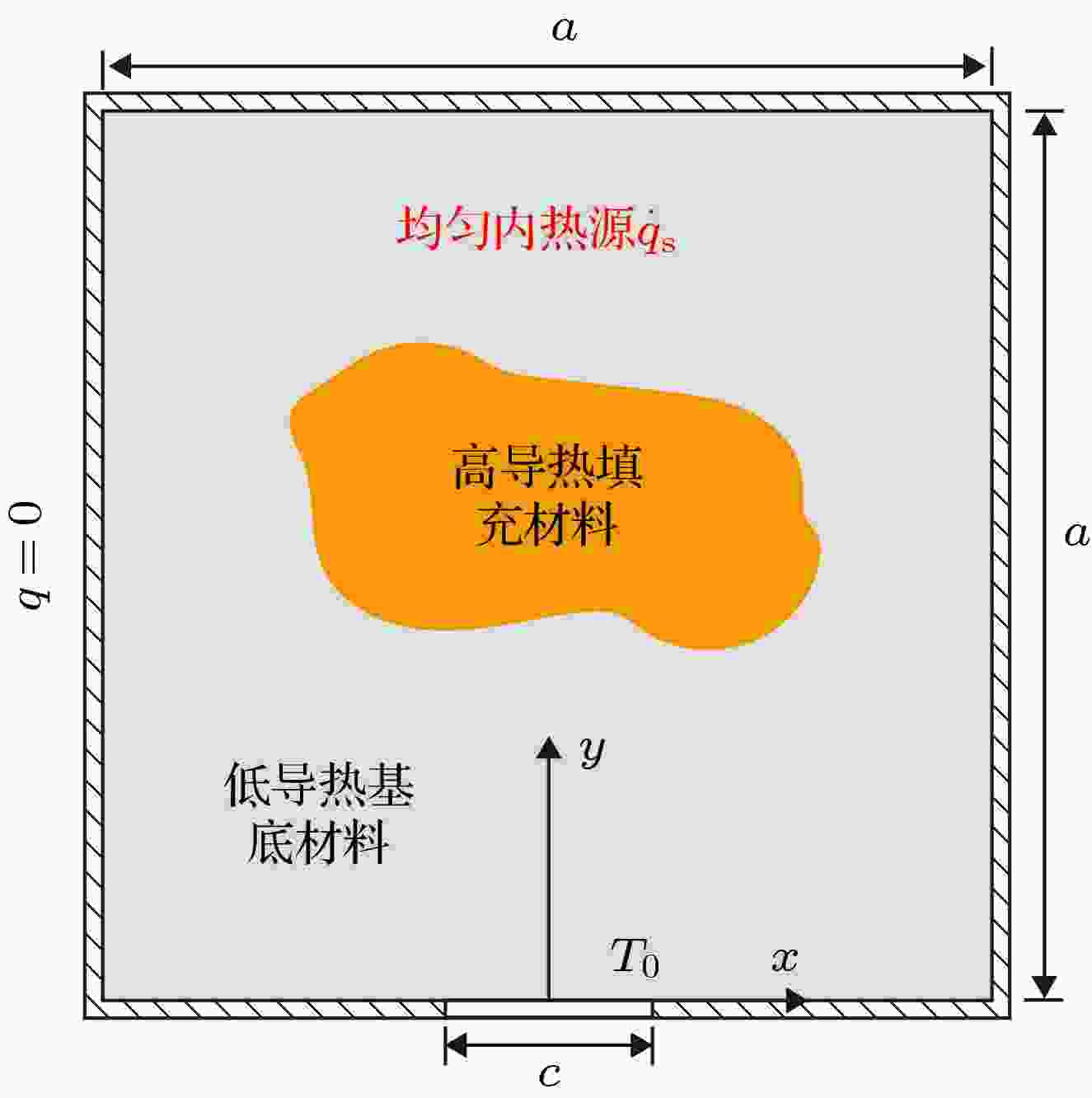
COVER ARTICLE
2019, 68 (20): 200201.
doi: 10.7498/aps.68.20190923
Abstract +
The volume-to-point (VP) heat conduction problem is one of the fundamental problems of cooling for electronic devices. The existed reports about the VP problem are mainly based on the Fourier’s law which works well at the macroscopic scale. However, the length scale of modern electronic devices has reduced to micro- and nano-scale, at which optimization methods that are capable of dealing with the non-Fourier heat conduction are desired now. In this paper, phonon Boltzmann transport equation (BTE) and solid isotropic material with penalization (SIMP) method are coupled to develop a topology optimization method for ballistic-diffusive heat conduction. Phonon BTE is transformed into equation of phonon radiative transport, which is solved by the discrete ordinate method. To realize the topology optimization, SIMP method is adopted to penalize the phonon extinction coefficient, which equals to the reciprocal of phonon mean-free-path, and an explicit constraint on the global gradient of the nominal material density is used to ensure the solutions being well-posed and mesh-independent. By using the developed topology optimization method, it is found that the optimal material distributions for the VP problem in ballistic-diffusive heat conduction significantly deviate from the traditional tree-like structure obtained in diffusive heat conduction, and the results vary with the Knudsen number (Kn). This is related to the different coefficient interpolation ways in the SIMP method and phonon ballistic transport. When Kn → 0, instead of converging to the conventional tree-like structure which fully stretches into the interior zone, the new method gradually produces the result obtained by the topology optimization which interpolates the reciprocal of the thermal conductivity in diffusive heat conduction. As Kn increases, the high thermal-conductive filling materials show a trend to gather around the low-temperature boundary, and there are more thick and strong trunk structures, less tiny and thin branch structures in the optimized material distributions. In addition, the ratio of the optimized average temperature to the value of the uniform material distribution $\left( {T_{{\rm{ave}},{\rm{opt}}}^{\rm{*}}/T_{{\rm{ave}},{\rm{uni}}}^{\rm{*}}} \right)$ also increases. The dependence of the topology optimization results on Kn can be attributed to the size effect of the thermal conductivity caused by phonon ballistic transport. In the diffusive heat conduction, filling materials with different length scales have the same efficiency to build high thermal-conductive channels. However, with ballistic effect enhancing, size effect makes the effective thermal conductivities of the branch structure lower than those of the trunk structure, as the former is smaller than the latter. As a result, the branch structures are less efficient compared with the trunk structures in terms of building high thermal-conductive channels, and the optimal material distributions have more trunk structures and fewer branch structures. When the ballistic effect becomes significant enough, say at Kn = 0.1, the topology optimization gets a dough-like material distribution in which branches merge into trunks. The proposed topology optimization method have the potential to provide guidance in designing nanoscale electronic devices for improving the heat dissipation capability.
2019, 68 (20): 200401.
doi: 10.7498/aps.68.20191054
Abstract +
Black hole thermodynamics establishes a deep and satisfying link to gravity, thermodynamics, and quantum theory. And, the thermodynamic property of black hole is essentially a quantum feature of gravity. In this paper, in order to study the influence of the quantum gravity effect on the quantum properties of black hole, we study the thermodynamics and its quantum correction to a non-commutative black hole. First of all, the temperature of the non-commutative Schwarichild black hole is calculated by using three different methods: surface gravity, tunneling effects and the first law of black hole thermodynamics. It is found that the same hole temperature is obtained by means of the surface gravity and tunneling effects. However, by using the first law of black hole thermodynamics, different results are derived from the first two methods. Therefore, we incline to the result obtained by surface gravity and tunneling effects, and the temperature obtained by the thermodynamic law needs modifying. That is, for the non-commutative black hole, there is a contradiction to the first law of thermodynamics. To calculate the temperature and other thermodynamic quantities for the non-commutative Schwarichild black hole, we use the corrected first law of black hole thermodynamics proposed in the literature. It is found that the black hole temperature derived by the corrected first law is the same as the temperature obtained by the surface gravity and the tunneling model, and the black hole entropy still follows Beckenstein-Hawking area law. Also, the heat capacity of the black hole is obtained and analyzed. It is seen that when the horizon radius and non-commutative parameter satisfy the particular conditions, the heat capacity is positive and the non-commutative black holes are thermodynamically stable. This is a different result from that of the usual Schwarichild black hole. Further, by studying the influence of generalized uncertainty principle on non-commutative black hole thermodynamics, the quantum corrections from generalized uncertainty principle for temperature, entropy and heat capacity of the non-commutative Schwarzschild black hole are given. It is found that with considering this quantum gravity effect, the obtained black hole entropy contains the item of are alogarithm. If the effect of the generalized uncertainty principle is neglected, the corrected black hole entropy can return to that in the usual case of Beckenstein-Hawing area law. Similarly, the corrected black hole temperature and heat capacity can also return to their counterparts in the case of usual Schwarzschild black hole when this quantum gravity effect is ignored.
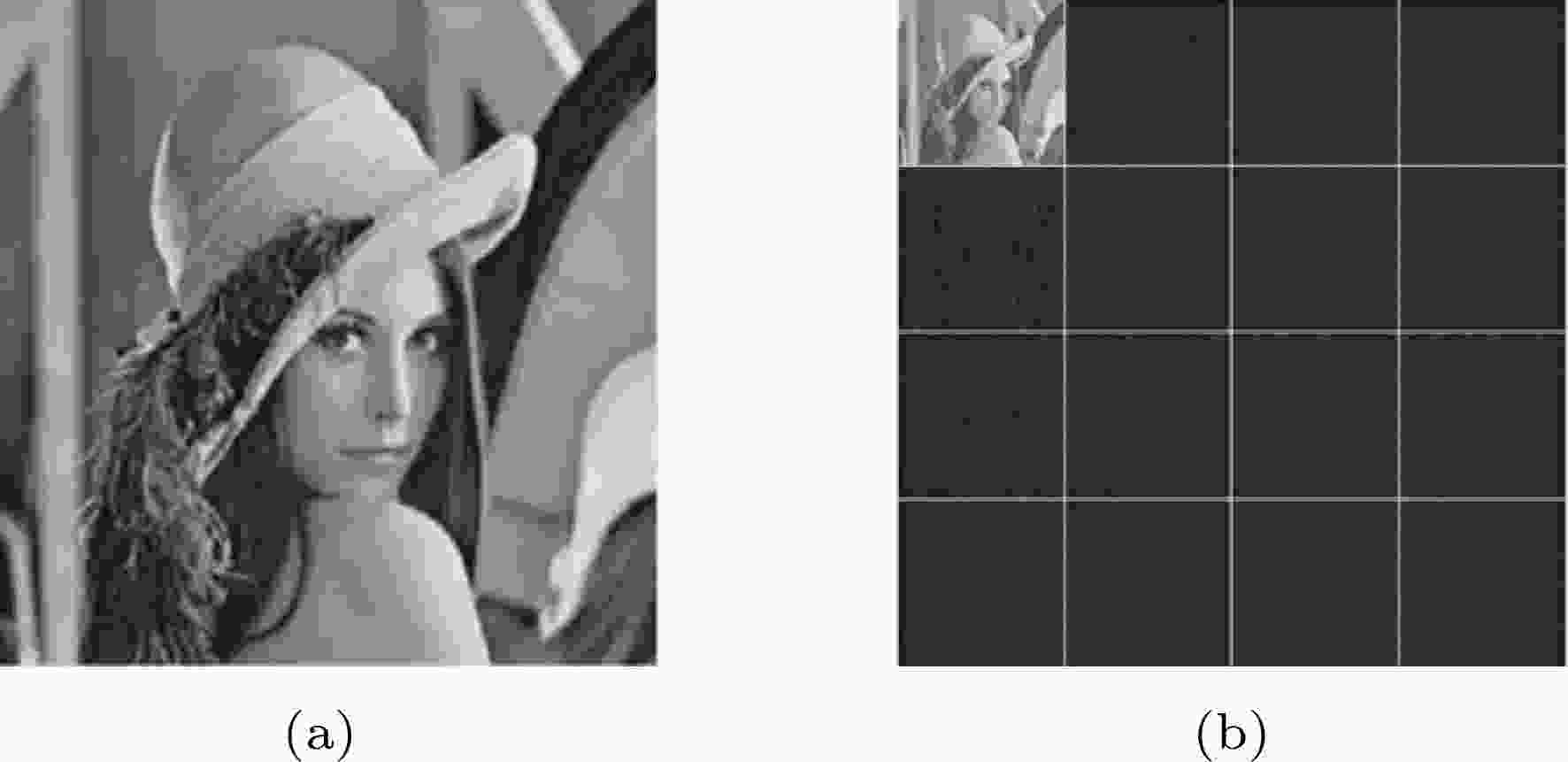
2019, 68 (20): 200501.
doi: 10.7498/aps.68.20190553
Abstract +
With the rapid development of computer science, the storage and dissemination of information are often carried out between various types of computer hardwares and various networks. The traditional information encryption scheme has gradually disappeared. Therefore, computer-based information encryption algorithms have gradually become a research hotspot in recent years. By combining the theory of wavelet packet transform, compressed sensing and chaotic system, a multi-process image encryption scheme based on compressed sensing and multi-dimensional chaotic system is proposed. The encryption scheme implements compression and encryption for grayscale images and corresponding decompression and decryption process. The wavelet packet transform theory is applied to the image preprocessing stage to perform wavelet packet decomposition on the original image. At the same time, the image signal components obtained by the decomposition are classified according to the threshold processing method, and the characteristics of the image signal components are processed in the subsequent processing. They are compressed, encrypted, or reserved in a differentiated manner. In the image compression stage, by introducing the compressed sensing algorithm to overcome the shortcomings of the traditional Nyquist sampling theorem, such as high sampling cost and low reconstruction quality, the compression efficiency and compression quality are improved while the ciphertext image reconstruction quality is guaranteed. In the image encryption stage, the encryption scheme combines multi-class and multi-dimensional chaotic systems to confuse and scramble the related image signal components, and introduces a high-dimensional chaotic system to make the encryption scheme have a large enough key space to further enhance the ciphertext image reliability. Finally, the complete reconstruction of the original image is achieved by applying the inverse of compression, encryption and wavelet packet transform. The simulation results show that the image encryption scheme effectively protects the basic information about ciphertext images by virtue of algorithm robustness against external interference, and does not reveal any useful information when dealing with cracking methods such as plaintext attacks. In addition, the information entropy and correlation coefficient of ciphertext images encrypted by this encryption scheme are closer to ideal values than those of the encryption algorithm in the references, and its encryption performance is significantly improved.
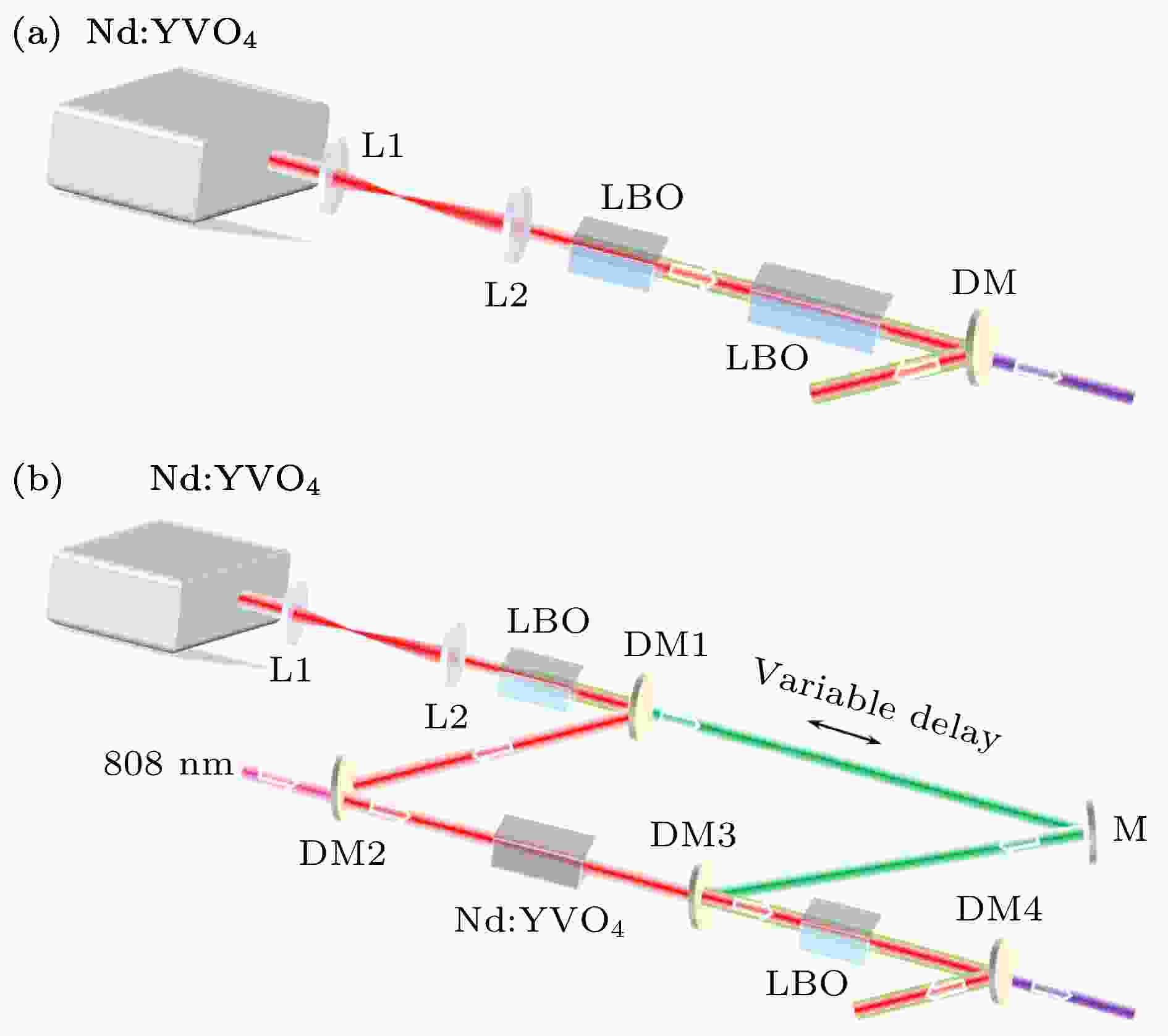
2019, 68 (20): 200601.
doi: 10.7498/aps.68.20190876
Abstract +
In recent years, picosecond laser in ultraviolet (UV) has manifested great importance for applications both in science and industry, such as biomedical research, micro machining, etc. Now, the well proven approach to generating ultra-short UV pulses is extra-cavity frequency conversion based on nonlinear optical (NLO) crystal, due to the lack of suitable laser sources directly generating UV laser. In this process of harmonic generation, the length of nonlinear crystal is an important factor affecting the conversion efficiency and beam-quality. The optimal length of the nonlinear crystal is influenced by incident laser parameters and crystal absorption coefficient. At present, for the UV 355 nm picosecond laser generated from extra-cavity sum frequency, published are few reports about detailed analysis and research on the influence of photon ratio of the incident laser beams and nonlinear crystal absorption on optimal length of sum frequency crystal. In this paper, the steady-state solutions with the highest conversion efficiency under different incident conditions are obtained by theoretical analysis and numerical simulation of the three waves coupling equations. The effects of different photon ratios and absorption effect of the sum frequency crystal on the optimum crystal length are analyzed. We propose a solution based on the fundamental frequency laser amplified to shorten crystal length and improve conversion efficiency. In this scheme, the 532 nm second harmonic laser with a high conversion efficiency over 65% can be achieved by LiB3O5 crystal. After that, the 1064 nm fundamental frequency laser is separated from the second harmonic laser, and then it is amplified by the Nd:YVO4 laser crystal pumped by an 808 nm laser diode. Finally, the ultraviolet 355 nm picosecond laser is obtained by combining the 1064 nm fundamental frequency laser with the 532 nm second harmonic laser in the LiB3O5 crystal. The simulation results show that the incident photon ratio of the sum frequency reaction can be changed by amplifying the residual fundamental frequency laser, and the optimum length of the sum-frequency crystal corresponding to the highest conversion efficiency can be shortened. Meanwhile, the absorption and walk-away effect of the sum frequency crystal can be also reduced. The final 355 nm laser output power can be increased more than 40 percent compared with the traditional scheme of early reports. In consequence, the high sum frequency conversion efficiency of the UV 355 nm picosecond laser can be obtained by changing the photo ratio of the incident laser beams through amplifying the fundamental frequency laser.

2019, 68 (20): 200701.
doi: 10.7498/aps.68.20190643
Abstract +
Traditional Monte Carlo simulation requires a large number of samples to be employed for calculating various physical parameters, which needs much time and computer resources due to inefficient statistical cases rather than mining data features for each example. Here, we introduce a technique for digging information characteristics to study the phase transition of polymer generated by Monte Carlo method. Convolutional neural network (CNN) and fully connected neural network (FCN) are performed to study the critical adsorption phase transition of polymer adsorbed on the homogeneous cover and stripe surface. The data set (conformations of the polymer) is generated by the Monte Carlo method, the annealing algorithm (including 48 temperatures ranging from T = 8.0 to T = 0.05) and the Metropolis sampling method, which is marked by the state labeling method and the temperature labeling method and used for training and testing of the CNN and the FCN. The CNN and the FCN network can not only recognize the desorption state and adsorption state of the polymer on the homogeneous surface (the critical phase transition temperature TC = 1.5, which is close to the critical phase transition temperature TC = 1.625 of the infinite chain length of polymer adsorbed on the homogeneous surface regardless of the size effect), but also recognize the desorption state, the single-stripe adsorption state and the multi-stripe adsorption state of polymer on the stripe surface(the critical phase transition temperature T1 = 0.55 and T2 = 1.1, which are consistent respectively with T1 = 0.58 and T2 = 1.05 of polymer adsorbed on the stripe-patterned surface derived from existing research results). We obtain almost the same critical adsorption temperature by two different labeling methods. Through the study of the relationship between the size of the training set and the recognition rate of the neural network, it is found that the deep neural network can well recognize the conformational state of polymer on homogeneous surface and stripe surface of a small set of training samples (when the number of samples at each temperature is greater than 24, the recognition rate of the polymer is larger than 95.5%). Therefore, the deep neural network provides a new calculation method for polymer simulation research with the Monte Carlo method.
ATOMIC AND MOLECULAR PHYSICS
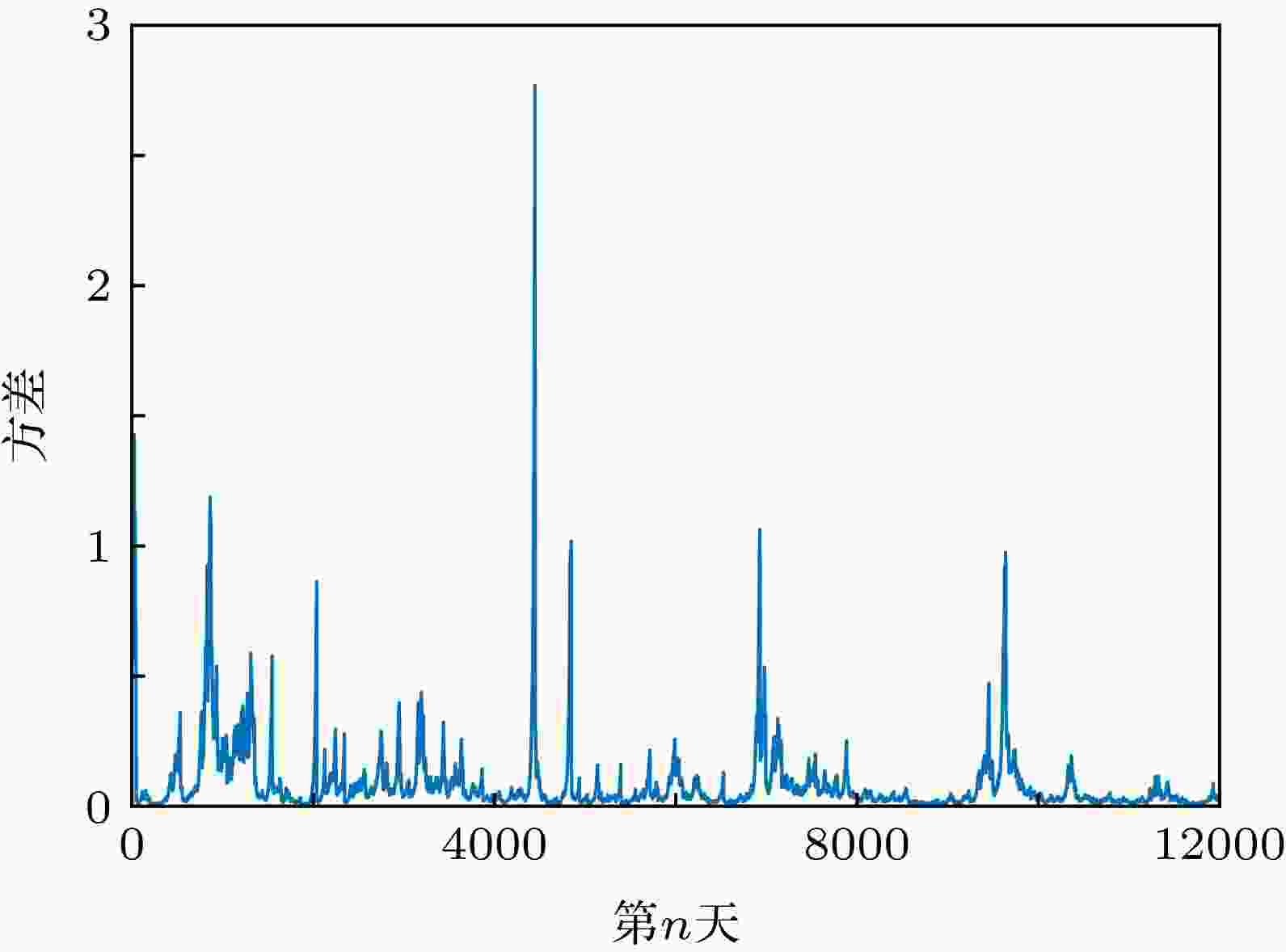
2019, 68 (20): 203101.
doi: 10.7498/aps.68.20190714
Abstract +
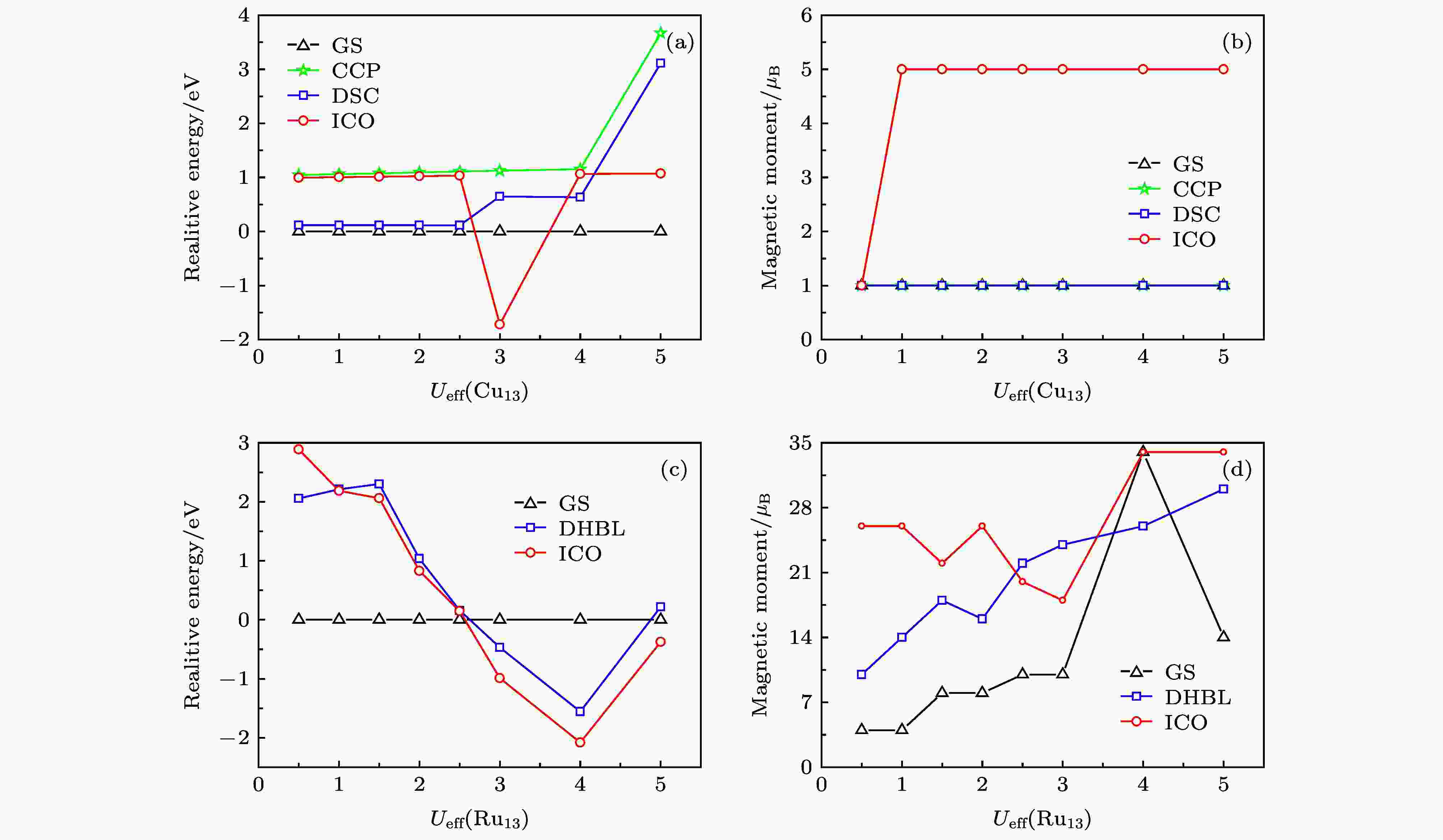
2019, 68 (20): 203102.
doi: 10.7498/aps.68.20190737
Abstract +
The stability of structure, spin, orbital magnetic moment and magnetic anisotropy energy of TM@Cu12N12 (TM = Mn, Fe, Co, Ni, Cu, Ru, Rh, Pd, Ir, Pt) are systematically investigated within the framework of the generalized gradient approximation with on-site coulomb repulsion density-functional theory (DFT-GGA+U). In the orbital moment and magnetic anisotropy energy (MAE) computation procedure, the spin-orbit coupling is considered and implemented. In this article, we mainly focus on the structure stability and tunable magnetism of the TM atom (Mn, Fe, Co, Ni, Cu, Ru, Rh, Pd, Ir, Pt) substituting the centre atom of icosahedron (ICO) Cu13N12 cluster, finally disclose the physics origin of the structure stability, change magnetism and larger MAE. The results show that the different TM atom doping makes the ICO structure of Cu13N12 cluster appears a tiny deformation. The stabilities of the clusters are evidently enhanced due to the formation of Cu—N and Cu—TM bond. In addition, the N-capped clusters more prefer to present a larger magnetic moment than the pure Cu13 one. The magnetic environment of clusters is improved to varying degrees by doping different TM (TM = Mn, Fe, Co, Ni, Cu, Ru, Rh, Pd, Ir, Pt) atoms, which endows TM@Cu12N12 clusters with various magnetic properties. For instance, the doping of 3d atoms further enhances the spin magnetic moment of the clusters, the Mn, Fe and Co atoms replacing the centre atom of the ICO Cu13N12 generate 35, 32 and 33 giant moments, respectively. In light of the doping of 4d, 5d transition metal atoms, the orbital moments of the TM@Cu12N12 clusters do not increase evidently, but the MAE remarkably strengthens for the doping of Rh and Pt atoms, the MAE values reach to 15.34 meV/atom and 6.76 meV/atom for Rh@Cu12N12 and Pt@Cu12N12, respectively. The tunable magnetism of TM@Cu12N12 cluster provides promising applications in spintronics.

2019, 68 (20): 203401.
doi: 10.7498/aps.68.20190884
Abstract +
Ce is a rare earth element in the periodic table. In the range of low temperature and low pressure, there are two face-centered-cubic (FCC) phases (α-Ce and γ-Ce) and a double-hexagonal-close-packed phase (β-Ce) for metallic Ce. At ambient temperature and about 0.7 GPa pressure, Ce undergoes γ→α phase transition with a volume shrink of 14%–17% discontinuously. In this paper, an embedded-atom method (EAM) potential compatible for α-Ce and γ-Ce was developed. This EAM potential has been employed to study several basic properties of cerium in these two FCC phases, such as equilibrium lattice constants, cohesive energies, and elastic constants. These results showed good accordance with experiments and first principle calculations. The lattice defects have been studied with the formation energy calculations of vacancies, interstitials, surfaces, stacking faults, and twinning defects in α-Ce and γ-Ce lattice. The lattice dynamics of α-Ce and γ-Ce have been analyzed using our EAM potential. The lattice vibrational entropy was calculated and plotted as functions of temperature for each phases. The vibrational entropy change across the α-γ phase transition showed to be ~0.67 kB per atom at ambient temperature. Using molecular dynamics simulation with our EAM potential, several isotherms and radial distribution functions were calculated. These isotherms and radial distribution functions demonstrate a first order phase transition between two FCC structures, corresponding to α-Ce and γ-Ce, with a critical point sets at Tc≈550 K and Pc≈1.21 GPa. Thus the newly developed EAM potential could provide a reasonable description of FCC Ce and its α-γ phase transition within the scale of classical molecular dynamics simulation.
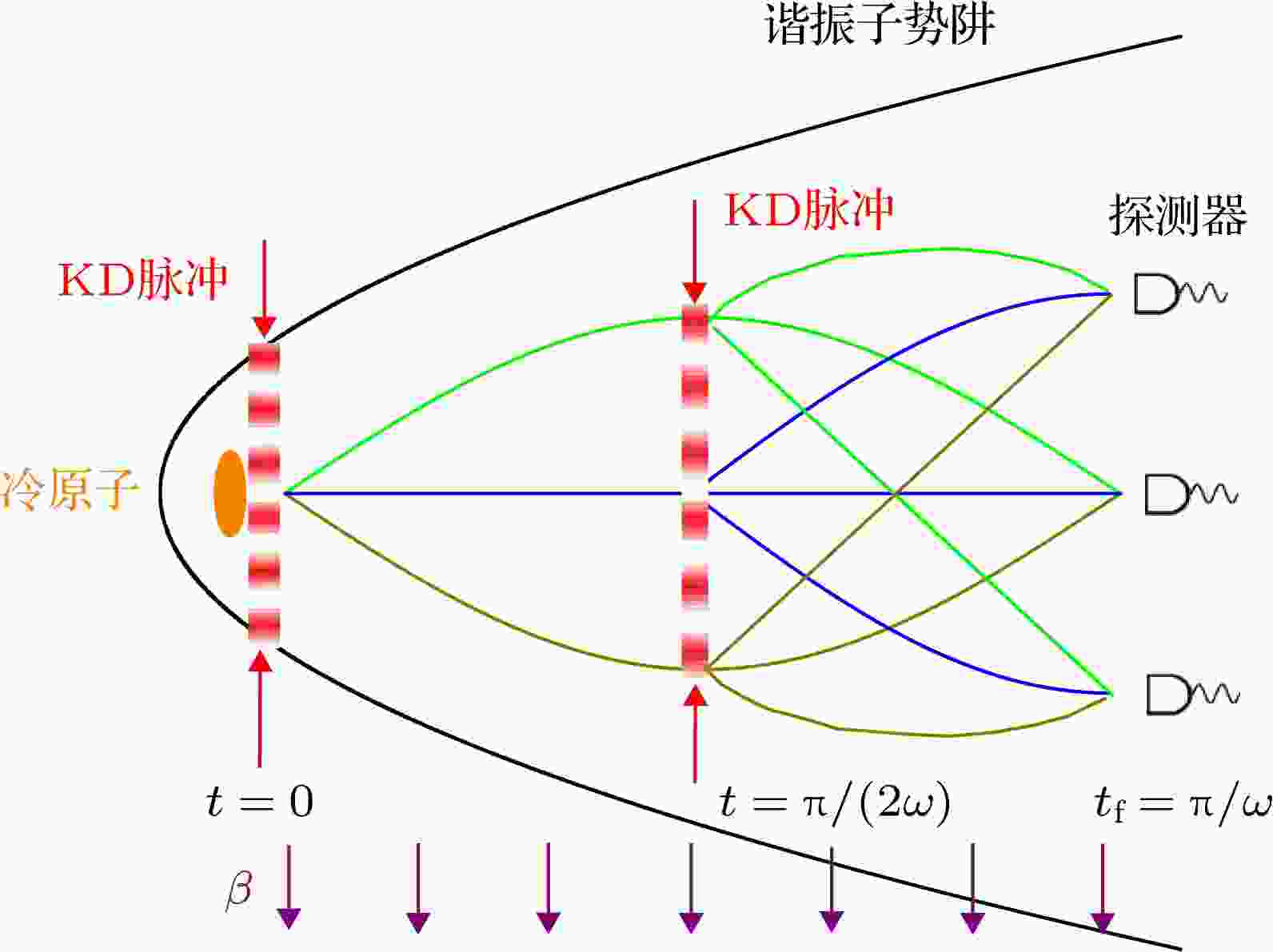
EDITOR'S SUGGESTION
2019, 68 (20): 203701.
doi: 10.7498/aps.68.20190749
Abstract +
The interferometry of two Kapitza-Dirac (KD) pulses acting on cold atoms in a harmonic oscillator potential well is investigated by Feynman path integral method. The wave function and density distribution function of the system at a given time are calculated analytically by using the propagator under the action of an external field. The first KD pulse acts on cold atoms to produce a large number of modes in the harmonic oscillator potential well. The maximum value of wave packet of mode 0 is larger than those of other modes. These modes evolve along different paths. The external field changes the phase of each mode and makes the evolution path of the mode deviate from that without the external field. When the second KD pulse is added, it splits the mode of the first KD pulse, and thus generates more modes. These modes will evolve along different paths under the action of external field and harmonic potential well, and interfere with each other. At the moment of measurement, all the wave packets are separated without overlapping. The effect of the external field does not change the magnitude of the density distribution at the time of measurement, but makes the wave packet of each mode shift. The phase difference between adjacent modes decreases linearly with the increase of field intensity. When the external field is a gravity field, we calculate the Fisher information and the Cramer-Rao lowér bound. The Fisher information is proportional to the mass of atoms and inversely to the third power of harmonic potential well frequency. We can improve the measurement accuracy of interferometer by reducing the frequency of harmonic potential well and increasing atomic mass. When the initial state is the ground state of the harmonic potential well, the accuracy of the gravity acceleration measured by the interference device can be obtained to be 10–9 by using the experimental parameters. The initial state is the ground state of the harmonic potential well and the external field, and the calculation result indicates that the measurement accuracy will decrease. At the same time, the enhancement of inter-atomic repulsion and attraction interaction will also lead the measurement accuracy to increase.
ELECTROMAGNETISM, OPTICS, ACOUSTICS, HEAT TRANSFER, CLASSICAL MECHANICS, AND FLUID DYNAMICS
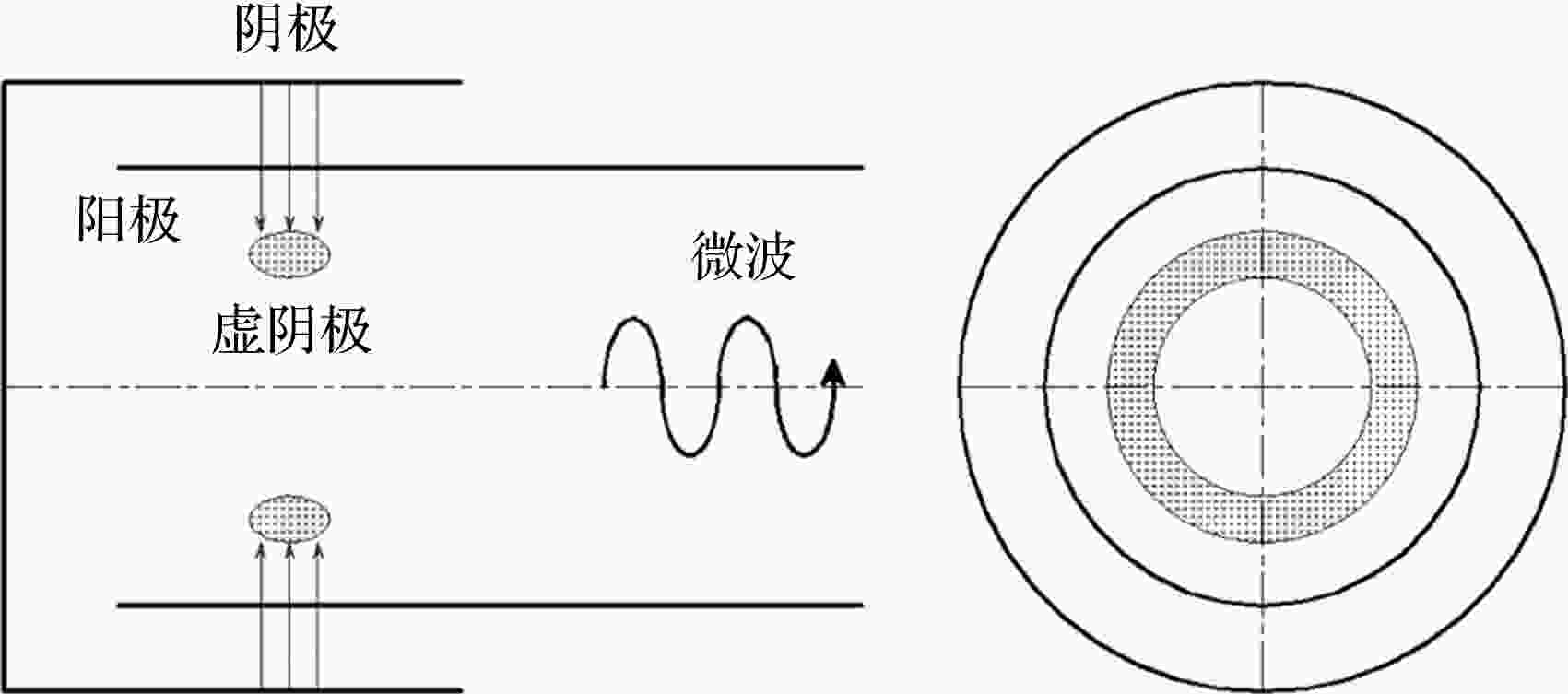
2019, 68 (20): 204101.
doi: 10.7498/aps.68.20190696
Abstract +
Virtual cathode oscillator, as a kind of space-charge high-power microwave source, has an output microwave mode that is generally an admixture of TM01 mode and TE11 mode. The analysis of the resonator in the anode mesh shows that when the transmission of the anode mesh is high, it is easy to produce strong reflected electron beam, forming a conical quasi-resonator structure, thus enhances the output of TE11 mode. When the transmission of the anode mesh is low, the beam intensity of the reflected electron beam can be weakened due to the absorption of the metal mesh, and the TE11 mode can be suppressed, so the output mode is mainly TM01 mode. In this paper, a feedback coaxial virtual cathode oscillator is investigated with the use of numerical simulation and experimental data analysis. The feedback coaxial virtual cathode oscillator is formed by closing the end of the anode mesh through a metal plate and changing the path of the reflected electron beam from the metal mesh to the gap between cathode and anode. The particle in cell method is used in the numerical simulation of the virtual cathode oscillator, and the impedance of the 400 kV diode is about 13 Ω under a voltage of 400 kV. After the optimal design by numerical simulation, the average output microwave power from the virtual cathode oscillator is 1.5 GW, and the frequency of the microwave is about 4.2 GHz, which is basically consistent with the theoretical calculation results. In this new kind of virtual cathode oscillator, the distribution of reflected electrons is modified by the feedback sheet on the anode mesh, the output high power microwave pattern is demonstrated to be dominated by TM01 mode. The microwave power obtained in the experiment is measured by the array antenna power density integration method. For axisymmetric mode, a receiving antenna array is formed by placing multiple receiving antennas on one side of the axis of the antenna pattern. The power densities of different angles on the horizontal circumference with the phase center of the transmitting antenna are measured, the average power density of two adjacent points is multiplied by the area of the spherical belt between these two points, and then the resulting power is added by the power between the adjacent two points, thereby obtaining the total radiation power. With this method, the microwave power is 850 MW with frequency 4.1 GHz and pulse width 30 ns under slaving voltage 400 kV.

2019, 68 (20): 204201.
doi: 10.7498/aps.68.20190731
Abstract +
In a swept source-optical coherence tomography system, the telecentric scanning mode gives rise to central saturation artifacts,partial structural loss, and low SNR (signal-to-noise ratio) area in the corneal image, which affects the accuracy of corneal contour extraction. In order to solve this problem, in this paper we propose an automatic extraction algorithm for corneal image of low quality. This algorithm divides the image into high and low SNR region according to the standard deviation distribution of the cornea image. For the high SNR region, we localize the peak point to extract the contour. For the low SNR region, image enhancement is achieved by the registration and superposition of successive frames, which provides reference contour points for low SNR areas. Then corneal contour localization is achieved by weighing the advantages and disadvantages of reference contour points and local line fitting results. Finally, global polynomial fitting is used to achieve the whole corneal contour information. Experiments on the optical eye model show that comparing with the existing algorithms, the accuracy of corneal contour extraction is improved by 4.9% on average.
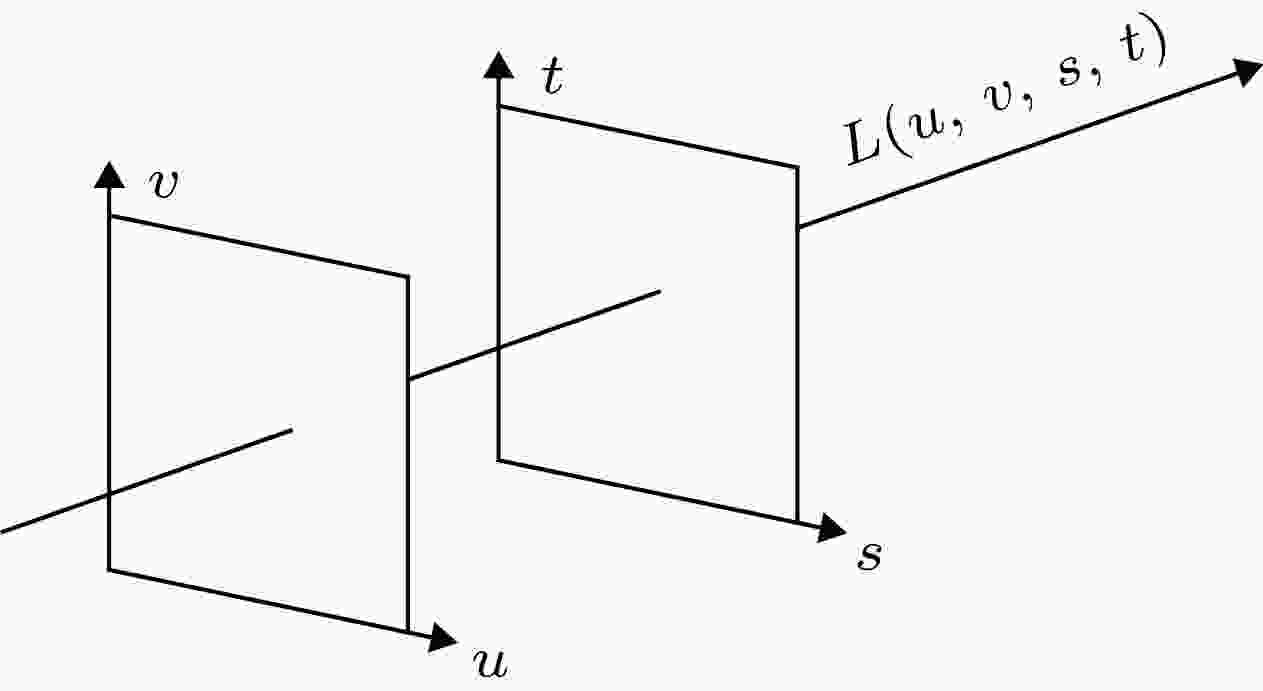
2019, 68 (20): 204202.
doi: 10.7498/aps.68.20190725
Abstract +
The light field imaging technology can realize the application of the full-focus image synthesis of the scene and the de-occlusion reconstruction of background target through the classification of the light field information of the scene. How to effectively evaluate the focus area in the image is a prerequisite for the above application. The dispersion characteristics of the defocusing point of a conventional imaging system are fundamentally different from those of the defocusing area in the refocusing image of the light field. Therefore, the evaluation criteria based on the diffusion characteristics of the defocusing point cannot be applied to the evaluation of the focus of the refocusing image of the light field. Aiming at the above problems, in this paper, starting from the principle of refocusing of light field imaging, we analyze the blurring characteristics of the defocused target image, and propose a new evaluation function of the focus of the refocusing image of the light field. Based on this, the refinement segmentation method of the focal region is studied to achieve the final focus area extraction. According to the indoor scene data set captured by the camera array of Stanford university, in this paper we use the traditional focus degree evaluation algorithm and the algorithm to evaluate the focusing degree of the foreground target potted plant in the scene and obtain the complete information about the foreground target, therefore we also study the refined segmentation algorithm. Then, in the process of refocusing the background object (CD box), the foreground light is screened out, and the reconstructed image of the specified focusing plane is obtained. Using the peak-signal-to-noise ratio and mean structural similarity index measure to evaluate the quality of the target in refocusing area, the results show that the proposed algorithm in this paper can effectively mark and separate the imaginary artifact information and ensure the high-quality focus reconstruction of the partially occluded target in the scene, which can effectively overcome the influence of the edge and texture information of the object in the scene on the defocusing area. The method presented in this work has better adaptability to the focus degree evaluation of the refocusing image of the light field.

2019, 68 (20): 204203.
doi: 10.7498/aps.68.20190529
Abstract +
Vertical cavity surface emitting lasers (VCSELs) are widely used in the field of short-range optical communication and optical interconnection because of their advantages such as low threshold current, large modulation bandwidth, easy two-dimensional integration, easy coupling with optical fibers and low cost. The VCSELs and heterojunction bipolar transistor (HBT) are longitudinal current devices, so they can be well integrated on the same wafer, and the output light power can be modulated by the HBT base current. Integration of VCSELs and HBT are designed in this paper. The VCSELs and PNP InGaP/GaAs HBT form a direct series structure. The reflectivity of DBR is 99.72% at a resonant wavelength of 850 nm and 99.57% after adding HBT separately. Therefore, the addition of HBT has little influence on the reflectivity of DBR at the resonant wavelength. The electro-optical characteristics of the integrated structure are simulated by using PICS3D software. An interim collector is added into the model in order to ensure that the simulation can be carried out smoothly. Firstly, HBT is conducted and the current flows from the emitter to the interim collector. Then, the voltage across the interim collector and the N-type electrode is increased to make VCSELs conducted and the current of the transition collector drop to zero. The interim collector can be removed from the actual structure because the current is zero. The simulation results show that the current gain coefficient is 400, and the maximum modulation rate of the base current to the output light power rises up to 280 mW/mA. The maximum temperature in the active region increases with the base current increasing, and the output light power first increases and then tends to be saturated. The ac optical gain characteristics of the integrated structure is simulated by PICS3D, and the simulation result shows that cutoff frequency exceeds 1 GHz. The addition of HBT limits the modulation rate of the integrated structure, and further optimization of HBT structure parameters and geometric dimension are needed to improve the modulation rate. The integrated structure and simulation method established in this paper can also be used to integrate LED, LD, DFB or other luminescent devices with HBT.
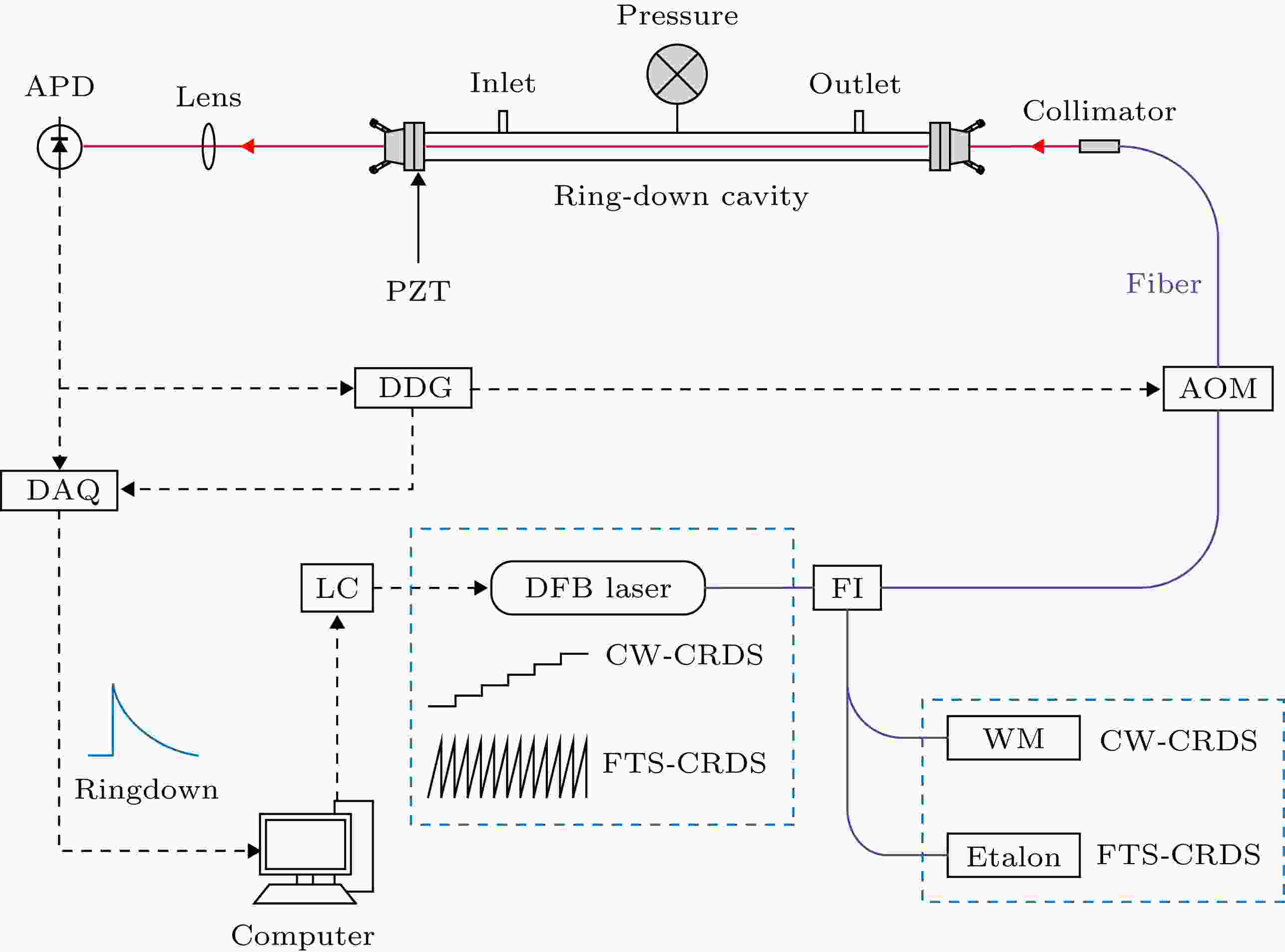
EDITOR'S SUGGESTION
2019, 68 (20): 204204.
doi: 10.7498/aps.68.20191062
Abstract +
Continuous wave cavity ring down spectroscopy (CW-CRDS) method with using cavity length scanning is ideal for accurately characterizing the low pressure spectra and measuring the small spectral parameters (such as the Dicke narrowing coefficient and the speed dependent collision broadening coefficient). However, the laser of any wavelength can be coupled to the cavity due to the cavity scan, so the spectral noise caused by the laser wavelength fluctuations cannot be ignored. This noise is non-uniformly distributed in the spectrum (especially on both wings on the spectral line) and is difficult to eliminate even with long-term averaging. Unlike the complex laser frequency locking techniques or the optical frequency combs or the better lasers, in this paper, a simple, easy to operate, fast wavelength-scanned CRDS method is proposed based on Fourier transform. The laser wavelength is continuously tuned across the absorption line to measure the periodic ring-down time. A reconstruction algorithm is developed to precisely recover the absorbance by extracting the characteristic frequencies of the periodic ring-down time after the Fourier transform. An etalon, instead of the wavelength meter, is used to calibrate the relative laser wavelength. This method effectively eliminates the non-uniform spectral noise caused by laser wavelength fluctuation in traditional CW-CRDS and significantly improves the measurement accuracy of spectral line parameters (especially line parameters in complex line shapes, such as speed dependent Voigt line shape) at low pressure. In addition, the measuring system, in which no wavelength meter is used, is simpler, more economical than CW-CRDS. The smaller residuals of the Galatry profile fit to the measured CO transitions at R(5) 6371.299 cm–1 and R(6) 6374.406 cm–1 show that the noise on both wings of the spectra, caused by laser wavelength fluctuation, is effectively reduced and the spectral SNR is then improved. The measured N2 perturbed collision broadening coefficient of the Voigt profile fit for CO is consistent with that from the classical CW-CRDS method and is in good agreement with the HITRAN2016 database. The measured N2 perturbed Dicke narrowing coefficient of the Rautian and Galatry profile and speed dependent collision broadening coefficient of the speed dependent Voigt profile have very good linear relationship with pressure, and have smaller uncertainties than the results from the CW-CRDS method.

2019, 68 (20): 204205.
doi: 10.7498/aps.68.20190575
Abstract +
The electronic structures and absorption spectra of LiTaO3 (LT) crystal and Fe:Mg:LiTaO3 crystal with different Mg concentrations are investigated by first-principles through using the density functional theory. The supercell crystal structures are established with 60 atoms with four models: the near-stoichiometric pure LiTaO3 crystal (LT); the iron doped LiTaO3 crystal (Fe:LT), with the charge compensation model expressed as FeLi2+-2VLi–; the iron and magnesium co-doped LiTaO3 crystal (Fe:Mg:LT), with the charge compensation model taken as FeLi2+-MgLi+-3VLi–; the other iron and magnesium co-doped LiTaO3 crystal (Fe:Mg(E):LT), with Mg ion concentration near threshold value (slightly less than 6 mol%) and taking the charge compensation model as 2MgLi+-FeTa2–. The geometry optimization results show that the total energy values of all models can achieve certain stable values, which means that the models used in this paper are very close to the actual crystal structures. In the electronic structures, the extrinsic defect energy levels in the forbidden band of Fe:LT crystal are mainly contributed from the Fe 3d orbital, and the band gap of Fe:LT about 3.05 eV is narrower than that of LT, the band gap of Fe:Mg:LT and Fe:Mg(E):LT sample are 2.72 eV and 2.45 eV respectively. The results show that the orbit of Fe 3d, Ta 5d and O 2p are superposed with each other, forming covalent bonds, which results in conduction band and valence band shifting toward low energy in iron doped LiTaO3 crystal. The Fe 3d orbit is split into Eg orbit and T2g orbit under the influence of the crystal field. There are two absorption peaks at 417 nm (2.97 eV) and 745 nm (1.66 eV) in the Fe:LiTaO3 crystal. The first one is attributed to the transfer of the T2g orbital electron to conduction band. The last one can be taken as the result of Eg electron transfer of Fe2+ in crystal. The intensities and positions of these peaks vary with the concentration of Mg ion. Specially, with the concentration of Mg ion attaining the threshold value, the peak at 745 nm disappears, and the other peak moves slightly to 457 nm (2.71 eV). With the Mg ion concentration at the threshold value, the Fe ions can occupy Ta positions. This occupying condition makes the Eg orbital energy change greatly compared with the scenario in the FeLi condition, and it affects hardly the T2g orbital energy. So, if the absorption nearby 745 nm waveband can be taken as the useful process in holographic storage application, it is better to take smaller concentration of Mg ions (less than threshold value). On the other hand, nearby 457 nm waveband, concentration of Mg ions can be chosen as a large value.
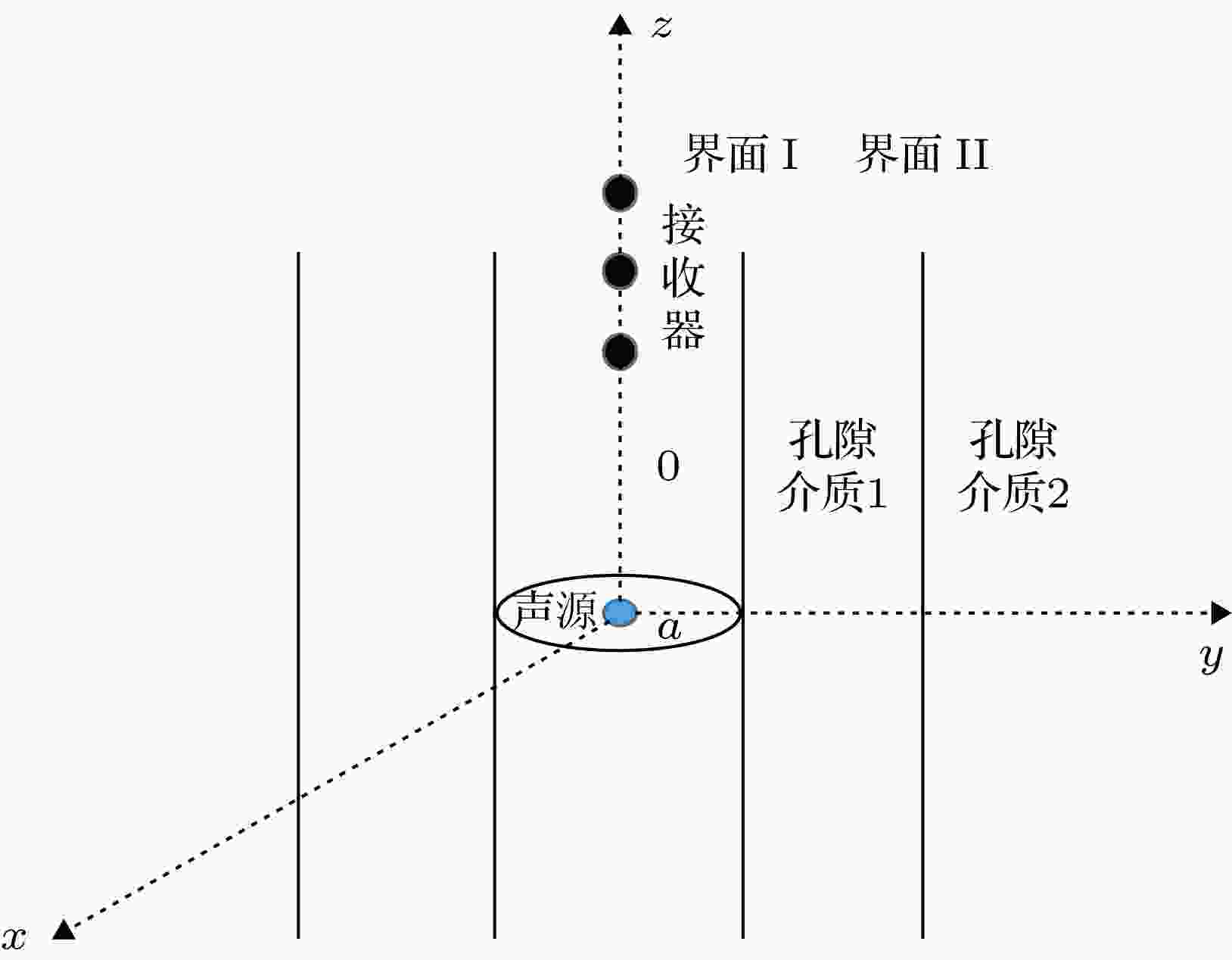
2019, 68 (20): 204301.
doi: 10.7498/aps.68.20190891
Abstract +
In recent years, electrokinetic effect has received wide attention. The electrokinetic effect refers to the coupling and conversion of acoustic waves and electromagnetic waves in a porous medium. Due to the electric double layer structure of porous medium, electromagnetic waves are generated during acoustic waves propagation in the liquid-containing porous medium. Based on this phenomenon, one proposes a method for electrokinetic effect logging.The electrokinetic effect has great application prospects in earthquake prediction and engineering exploration. The generation mechanism and propagation law of acoustic-electric coupling wave in electrokinetic effect logging of double-cylindrical-layer porous medium are explored in this paper. By calculating the vertical secant integral of the electric field branch point, the total response of the interface converted electromagnetic wave can be obtained. Previously, in the cylindrical layered medium, the secant integral corresponding to the borehole fluid and the inner layer medium branch point is zero. So the examples in this paper are calculated from the vertical secant integral of branch point kem2, which corresponds to the outermost infinite medium. It is found that when each time the longitudinal and transverse waves of the formation propagate to the interface, the interface converted electromagnetic waves are generated. These converted electromagnetic waves constitute the total response of the interface converted electromagnetic wave. At the same time, the influence of porous medium fluid salinity on interface converted electromagnetic wave is investigated. It is found that when only the inner layer porous medium fluid salinity changes, the amplitude of the interface converted electromagnetic wave response of the two interfaces is affected. When only the salinity of the outermost porous medium fluid changes, only the amplitude of the interface converted electromagnetic wave generated at the second interface is affected, but the interface electromagnetic waves generated at the internal interface are not influenced. When the difference in pore fluid salinity between both sides of the medium interface is larger, the amplitude of the interface converted electromagnetic wave is greater and the electromagnetic waves generated from the two interfaces are independent of each other.The case where fluid intrusion zone in porous medium is investigated, and the generation mechanism of interface converted electromagnetic wave is also studied when only a mineralization interface exists. It is found that the converted electric field is also generated when the acoustic waves propagates to the salinity interface. Since there exists neither multiple refraction of acoustic wave nor reflection of acoustic wave in the porous medium, the interface electromagnetic wave has only two wave packets, which are interface converted electromagnetic waves generated respectively at the borehole wall and at the electrochemical interface.The interface converted electromagnetic wave can be used to detect the location of the medium interface and the salinity interface. It can also clearly reflect the refraction and reflection law of wave propagating in stratified porous medium, which is of great significance for understanding the interface response mechanism of double-cylindrical-layer porous medium in electrokinetic effect logging.
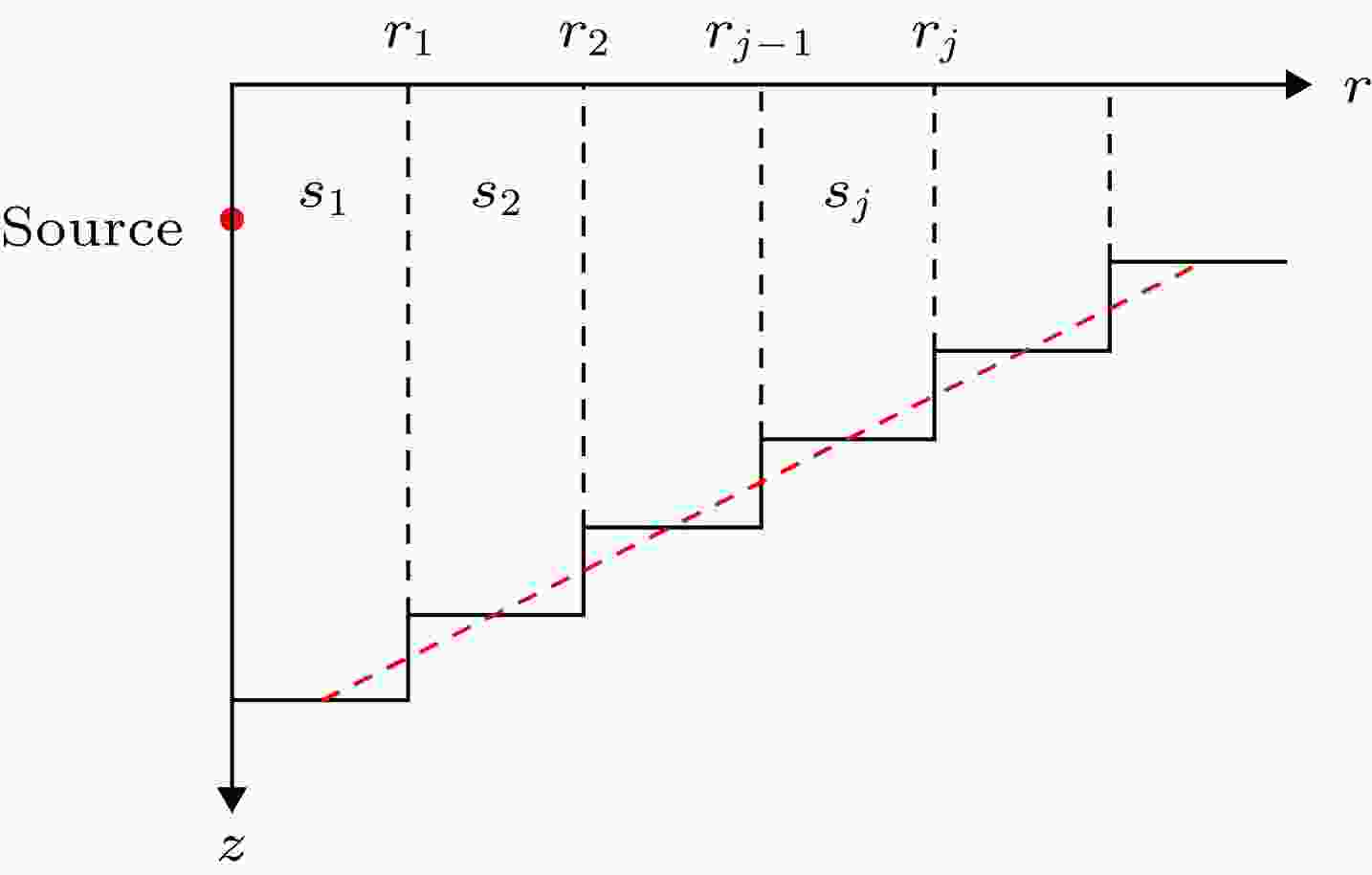
2019, 68 (20): 204302.
doi: 10.7498/aps.68.20190478
Abstract +
An accurate and numerically efficient numerical model is very important for studying the effect of internal wave on underwawter sound propagation. A full-wave, three-dimensional (3D) coupled-mode model is able to deal with the internal wave problem with satisfactory accuracy, but such a model is in general numerically inefficient. A numerically efficient 3D model is presented for sound propagation in a range-dependent waveguide in the presence of solitary internal waves in this work. The present model is a forward-marching model that neglects backscattering. In this 3D model, an efficient two-dimensional (2D) coupled-mode model, C-SNAP, is adopted to compute 2D acoustic field solutions excited by a line source. The C-SNAP is a 2D forward-marching model, which uses an energy-conserving matching condition to preserve accuracy. An appealing aspect of C-SNAP is that its efficiency is competitive with that of the existing parabolic equation model. The integral transform technique is used to extend C-SNAP to a 3D model, where a complex integration contour is used for evaluating the wavenumber integral. A brief review of C-SNAP and formulation of the present 3D model are given. The forward-marching models are primarily suitable for treating the range-dependent problems with weak backscattering, such as with a slowly varying bathymetry. Since in general the backscattering from internal wave is weak, which is also validated numerically in this work, the present model is able to address the problem of sound propagation through internal wave with satisfactory accuracy. At the same time, it achieves an efficiency gain of at least an order of magnitude over that of full two-way, 3D model. In addition to the internal wave, the present model is also suitable for solving the general range-dependent problems where backscattering is weak, such as in the presence of a bottom ridge of a small height. Numerical simulations are also provided to validate the present model, where a two-way, 3D model serves as the benchmark. The numerical results show that the effect of the internal wave on the acoustic field is negligible for the region between the source and the internal wave. However, the effect is significant on the other side of the internal wave. A more interesting observation is the angular dependence of the interference pattern induced by the internal wave.
2019, 68 (20): 204401.
doi: 10.7498/aps.68.20190144
Abstract +
Thermoelastic coupling model excited by laser is of great significance in engineering. To study the thermoelastic coupling model, the distribution of temperature field must be determined firstly. Because the laser excitation time is short (usually femtosecond), the traditional Fourier heat conduction law is no longer suitable. Therefore, it is necessary to establish the distribution of temperature field by using the non-Fourier heat conduction law. Previous studies on the temperature field model mostly use numerical analysis and computer simulation to discuss its numerical solution, but few can directly solve the analytical solution of the model. Up to now, there are few reports about using singularly perturbed analysis method to solve the asymptotic solution of temperature field model and determine the jumping position of heat conductivity coefficient. In this paper, a temperature field model is constructed by using the non-Fourier heat conduction law, i.e. a class of singularly perturbed hyperbolic equations with small parameters in an unbounded domain. The nonlinear singularly perturbed two-parameter hyperbolic equations with discontinuous coefficients are obtained when the heat conduction coefficients jump due to sharp temperature changes. By using the singularly perturbed biparametric expansion method, the asymptotic solution of the problem is obtained. First, the expansion of the problem is obtained by using singularly perturbed method. The existence and uniqueness of the internal and external solutions are obtained by estimating the maximum modulus of the internal and external solutions and the maximum modulus estimates of the time derivatives, and the formal asymptotic expansion of the solutions is obtained. Secondly, the singularly perturbed hyperbolic equation is corrected by the singular perturbation theory, and the derivative of the solution is estimated. The position expression of the jump of the thermal conductivity coefficient is determined by the Fourier transform, and the seam method is used to connect the seams of the two sides of the jump position of the thermal conductivity coefficient, thus the form asymptotic expansion of the solution is obtained. Finally, the uniform validity of the asymptotic solution is obtained by estimating the residual term, and the distribution of the temperature field with discontinuous heat conduction coefficient is obtained. In this paper, we have synthetically applied the knowledge of ordinary differential equations, partial differential equations, mathematical and physical equations, nonlinear acoustics, mathematical analysis, singular perturbation theory and so on, which enriched the study of non-Fourier temperature field model.
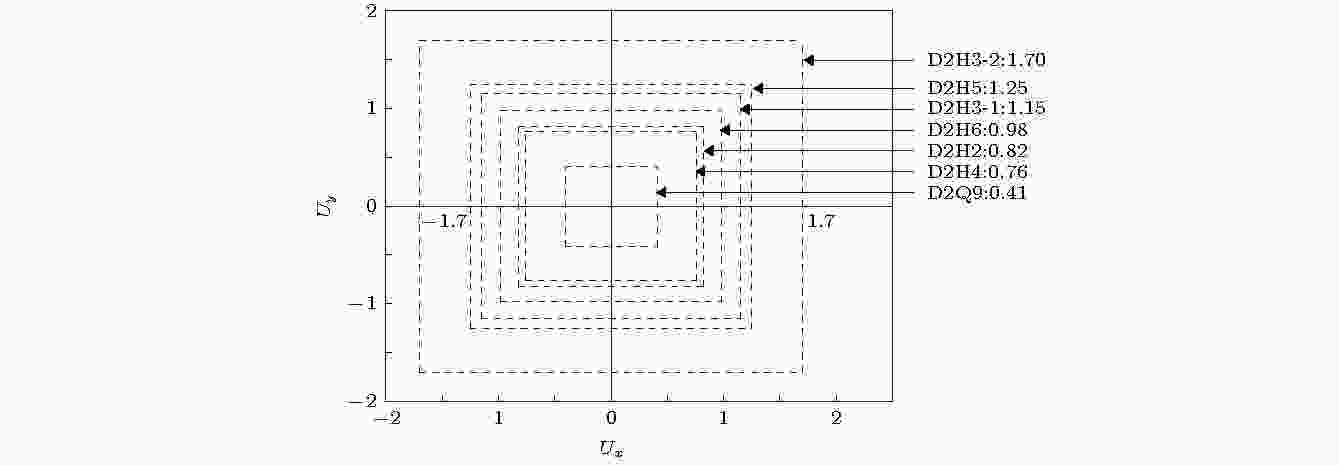
2019, 68 (20): 204701.
doi: 10.7498/aps.68.20190624
Abstract +
Traditionally, the numerical performance of the lattice Boltzmann method is mainly determined by the moment degree of a discrete equilibrium distribution. The equilibrium distribution positivity is merely considered as an ancillary property which is used to constrict the numerical configuration. With the newly-developed partial Gaussian-Hermite quadrature scheme, the positivity of equilibrium distribution is validated as an independent property like moment degree which can be adjusted by discrete velocities. Researchers speculated that the positivity should also be significant for the numerical performance by the lattice Boltzmann method and can be used to improve the performance. Comparing with the classical improvement through moment degree, the positivity approach will not bring additional computation. However, due to the lack of boundary treatment, the speculation has not been validated by detailed numerical simulations. In this paper, through employing a periodic case, the Taylor-Green vortex, to avoid the boundary issue, we in depth analyze the numerical effect of the model positivity, including the numerical accuracy in the model positive range, the influence of positivity on the numerical performance, and the significance comparison between positivity and moment degree. The results show that for a given model, the numerical accuracy is not consistent in the whole positive range. As the configuration is close to the border of positive range, the accuracy will degrade though it is still acceptable. The numerical performance of a model depends on both moment degree and positivity. The role that the moment degree plays lies mainly in the qualification of a model on Galilean invariance. Once a model fulfills the Galilean invariance, its numerical performance is solely dependent on the positivity. Hence, the improvement approach through modifying the model positivity is a viable solution, and a Galilean invariant model with wider positive range does possess a better numerical performance regardless of its moment degree. Furthermore, based on the numerical results in this paper, all DnHm
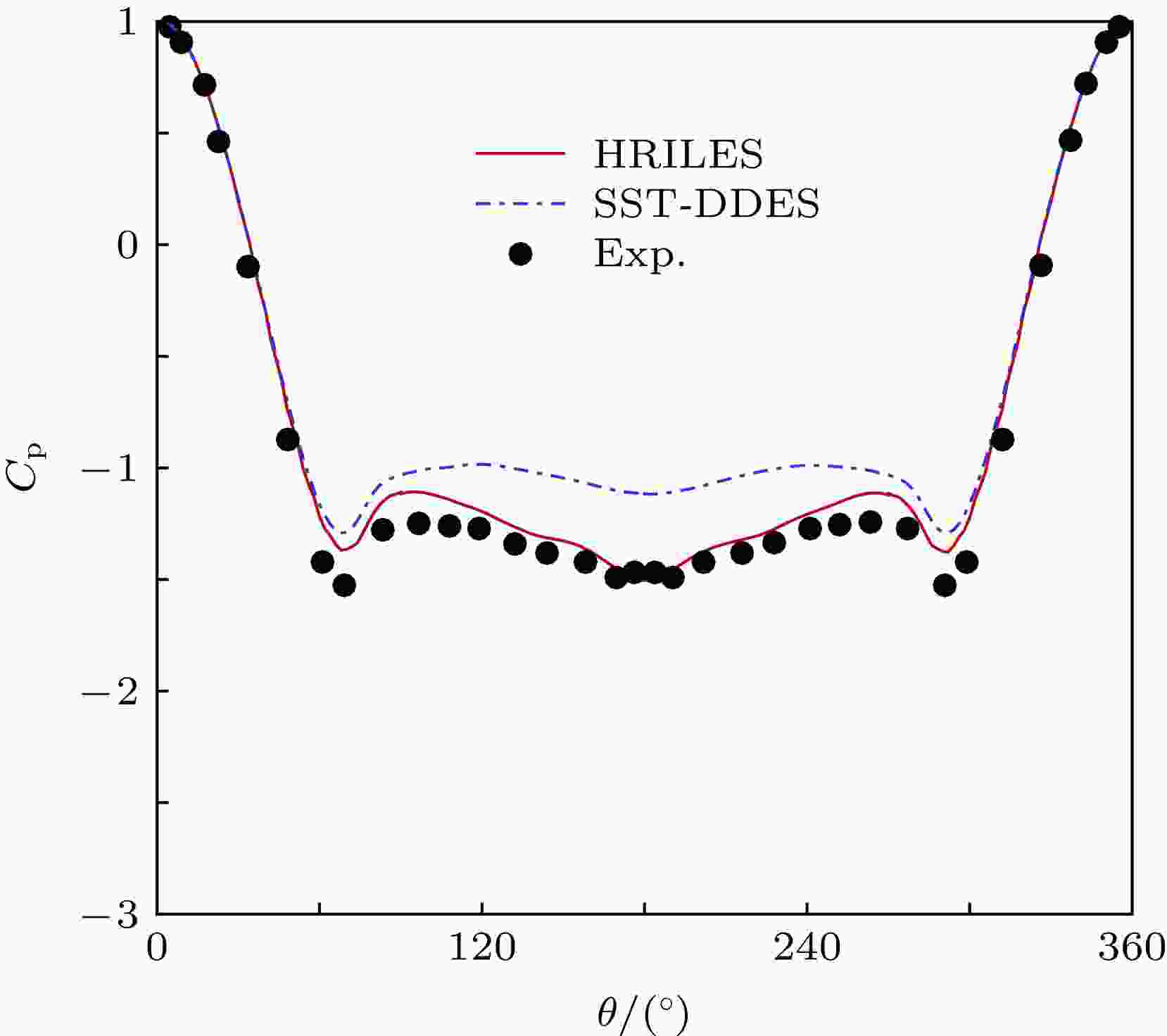
2019, 68 (20): 204702.
doi: 10.7498/aps.68.20190777
Abstract +
A hybrid RANS/HILES method (HRILES) is developed by combining the RANS-SST model and high order implicit large eddy simulation method (HILES) and employed with the Ffowcs Williams-Hawkings (FW-H) equation to predict the slat noise of 30P30N high-lift airfoil. Comparison has been made between the HRILES method and the traditional DDES based on the full-turbulence model SST by simulating the single cylinder case with $Re_{{d}}=4.3\times10^4$ . The HRILES method is able to predict the transition phenomenon and the small-scale separation bubble in the sub-critical wake region while the DDES can't and get a better mean wall pressure distribution than DDES. The amplitude and frequency spectrum of the far-field sound pressure level are in good agreement with the experimental data. In the simulation of 30P30N high-lift airfoil, the famous IDDES model is also used for comparison, both results are compared with experimental measurements. The computational mesh is provided by Japan Aerospace Exploration Agency (JAXA) in the Workshop on Benchmark problems for Airframe Noise Computations (BANC). The HRILES method obtains quantitative agreement with experimental data in terms of mean wall pressure coefficient, frequency spectrum of pressure fluctuations on the slat surface, and the mean flow statistics in the slat cusp shear layer. The IDDES model slightly underestimate the suction effect on the upper surface of the slat, and delays the instabilities in the slat cusp shear layer. The near-field noise spectra are compared with measurements obtained in JAXA low-speed Wind Tunnel. Narrow band peaks present are well recovered by both methods, while IDDES model overestimate the broadband noise. Far-field noise directivity results of every components, filtered in the band [256Hz–10KHz], are compared with each other, and the slat cove is confirmed to dominate the sound noise levels. The slat and flap noises show a typical dipole distribution, while the main wing noise's directivity is not apparent. Computational results show that the HRILES method, as one kind of generalized Hybrid RANS/LES method, HRILES can smoothly switch between the SST model and the HILES method. HRILES has the high-resolution simulation capability of the HILES in the LES region, and can reduce the requirements of the HILES method on the near-wall grid distribution by using the SST model in the inner boundary layer. As a result, the HRILES method has advantages in simulations at high reynolds numbers and aeroacoustic problems. Further research will be carried out in the applications at higher reynolds number flows with complex geometry in the future.

2019, 68 (20): 204703.
doi: 10.7498/aps.68.20190541
Abstract +
Water droplet impacting into a deep liquid pool is one of the most well-known flow phenomena in fluid mechanics. As a ubiquitous natural aeration process, the coalescence of water droplets in lakes and ponds and the subsequent bubble entrapment are one of the most notable ways of gas-liquid exchange in nature, and it is of great significance for underwater sound transmission, aquatic ecosystems and chemical process. The shape of an oscillating droplet in impact under different surrounding medium and initial condition is a key factor for the subsequent cavity formation and bubble entrapment. In this study, the adaptive mesh refinement technique and volume of fluid (VOF) method are applied to the study of the water droplet impact phenomena. Five kinds of deformed micron water droplets with different aspect ratios and impact velocities of 4 m/s and 6 m/s are selected to investigate the influences of drop deformation and impact velocity on the bubble entrapment, capillary wave propagation, and vortex ring evolution. The results show that at low impact velocities (Fr = 75, We = 64.4, Re = 1160, Vi = 4 m/s), the shape of water droplet does not cause the cavity formation and bubble entrapment to change significantly. However, under higher impact velocity (Fr = 112.5, We = 145, Re = 1740, Vi = 6 m/s), deformed droplet with an aspect ratio of 1.33 coalesces with the pool, and large bubble entrainment occurs. The large bubble entrapment is affected mainly by the vortex ring generated under the free surface at the neck between the droplet and the pool. The vortex ring penetrates more deeply before it pulls the free surface to generate a rolling jet at the upper interface of the cavity. The rolling jets then contact the center of the cavity and collapse to entrain a large bubble. At the end of the bubble entrapment phenomenon, the cyclone inside the cavity pushes the sidewall of the cavity continuously, and effectively increases the lateral volume of the bubble, which plays a vital role in the bubble entrainment process. In the initial stage of the impact, the flatter the shape of the droplet, the greater the curvature of the jet generated on the neck between the droplet and the pool, the greater the strength of the vortex ring generated under the free surface. However, the vortex ring formed by the oblate-shaped water droplet is generated too close to the free surface, and the early free surface pulling reduces the strength of the vortex ring, thus the vorticity maximum value decays relatively fast.

2019, 68 (20): 204704.
doi: 10.7498/aps.68.20190671
Abstract +
The spray characteristics of a liquid-liquid pintle injector under different momentum ratios are investigated experimentally in this paper. Water is used as a simulant medium for both the fuel and the oxidizer. By increasing the mass flow rate of the oxidizer or reducing the mass flow rate of the fuel, the local momentum ratio is increased from 0.16 to 0.99, wherein the responding total momentum obtained by the former throttling method is relatively high due to the higher mass flow rate of the fluid. The outer and inner spray boundary, droplet size distribution and the velocity field are studied by high-speed camera and phase Doppler anemometry (PDA). It is indicated that the spray pattern is affected by the operating conditions directly. The spray pattern is divided into the solid cone and the hollow-solid cone, generally. Furthermore, the spray pattern influences the other spray characteristics. Under the same local momentum ratio with different throttling methods, the spray angle is almost consistent, while the spray boundary in the far field is wider under the higher total momentum. With the increase of the mass flow rate of the outer injector, a hollow structure is generated in the near field of the spray, and its range expands with the increase of the local momentum ratio. The value of SMD increases with the local momentum ratio increasing. Under the same local momentum ratio, the variation range of SMD is wider under the higher total momentum. The variation trend of SMD in the radial direction differs from the spray pattern, too. The SMD of the hollow-solid spray displays as an " N” shape along the radial direction, and reaches its peak at the outer boundary. By contrast, the SMD of the solid spray decreases slightly in the radial direction and varies on a small scale. The value of the resultant velocity is determined by the total momentum, and the curves of all the resultant/axial/radial velocity display as an inverted " V” in the radial direction. Nevertheless, the trend of axial velocity in the radial direction is mainly decreasing, and the increasing stage only exists at the central spray. However, the radial velocity undergoes a slight decrease or levels off directly after reaching the peak. The higher the local momentum ratio, the larger the radial velocity is, while the lower the axial velocity. In addition, the velocity field below the hollow field is dominated by the liquid film, which is explained by analyzing the impinging process of the neighboring cloaks in this paper.
Original Articles
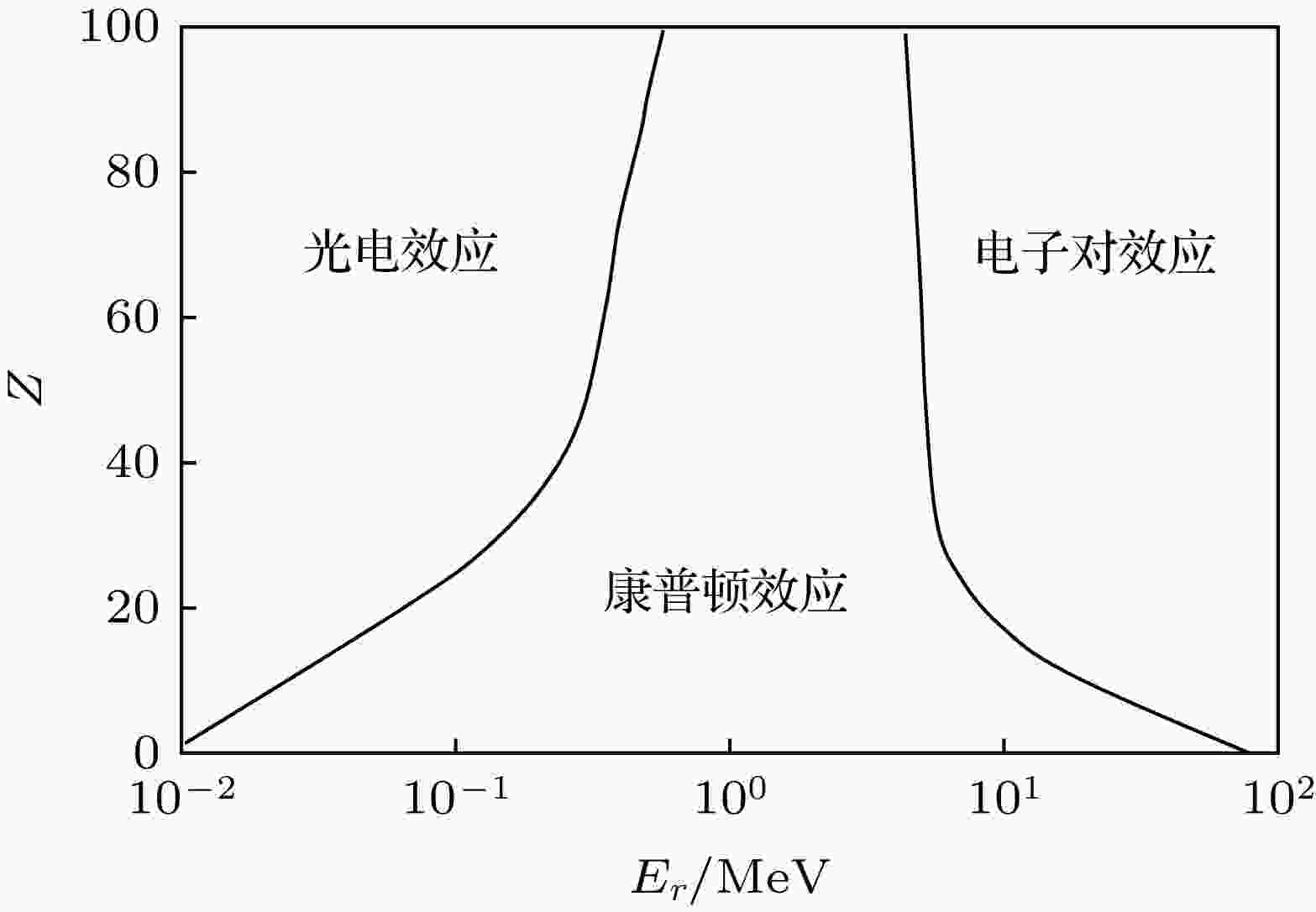
2019, 68 (20): 204206.
doi: 10.7498/aps.68.20190543
Abstract +
Silicon photonics is a fundamental technology, which has great potential applications in optical interconnection for telecom, datacom, and high performance computers, as well as in bio-photonics. Currently considered are the photonics integrated circuits that are able to work in harsh environments such as high energy equipment and future space systems including satellites, space stations and spacecraft. The understanding of the radiation effects of the photonics devices is critical for fabricating radiation hardened photonic integrate chips and maintaining the performance of the devices and the systems. In this paper, the recent progress of the radiation effects of silicon photonic components is summarized. The effects of the high energy particles that possibly degrade the performance of the device are explained, and the response of the passive and active device under radiation are reviewed comprehensively, including waveguides, ring resonators, modulators, detectors, lasers and optical fibers and so on. For passive devices, radiation-induced effects include accelerated-oxidation of the structures, radiation-generated lattice defects, and amorphous densification or compaction in the optical materials. The effective refractive index of the passive device may change consequently, leading the working frequency to shift, the optical confinement to decrease, and the optical power to leak, which accounts for the extra loss or other performance degradation behaviors. For photodetectors and lasers, radiation-induced displacement damage will be dominant. The induced point defects localized in the silicon layer bring about deep level in the forbidden band, acting as generation-recombination centers or trap centers of tunneling effect, which will compensate for either donor or acceptor levels, degrading the response of these optoelectronic device significantly. The plasma dispersion effect is the mainstream approach to building the silicon electro-optic modulators, which will suffer ionization damage in the high energy particle environment, because the interface-trapped hole caused by ionizing radiation reduces the carrier concentration in the depletion region and even induces the pinch-off of the p-doped side of the modulator, which may result in device failure. To improve the radiation hardness of the silicon photonic device, the passivation of the surface, optimization of the waveguide shape, and the choice of appropriate thickness of the buried oxide layer are possible solutions, and more effective approaches are still to be developed.
PHYSICS OF GASES, PLASMAS, AND ELECTRIC DISCHARGES
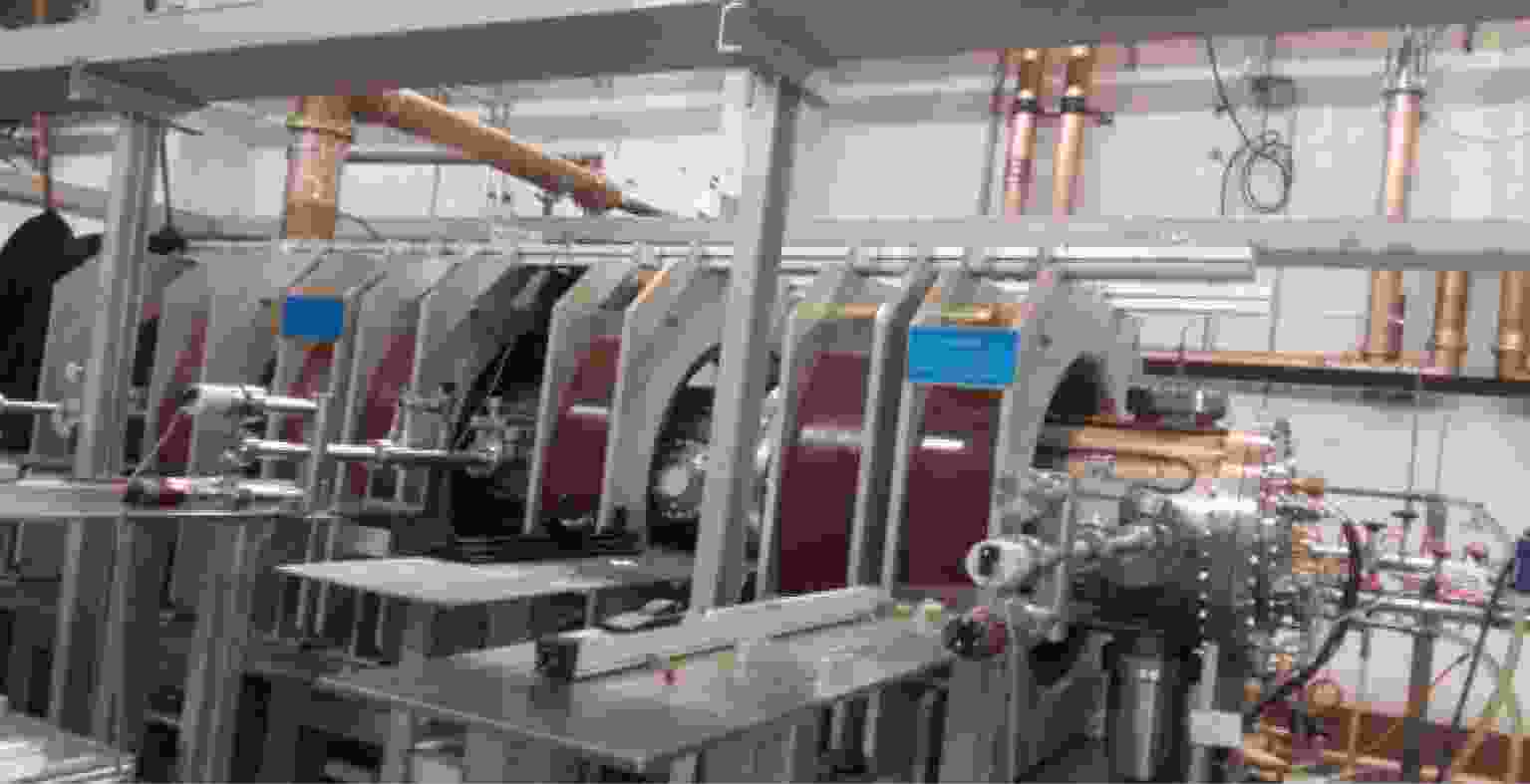
2019, 68 (20): 205201.
doi: 10.7498/aps.68.20182107
Abstract +
CONDENSED MATTER: STRUCTURAL, MECHANICAL, AND THERMAL PROPERTIES
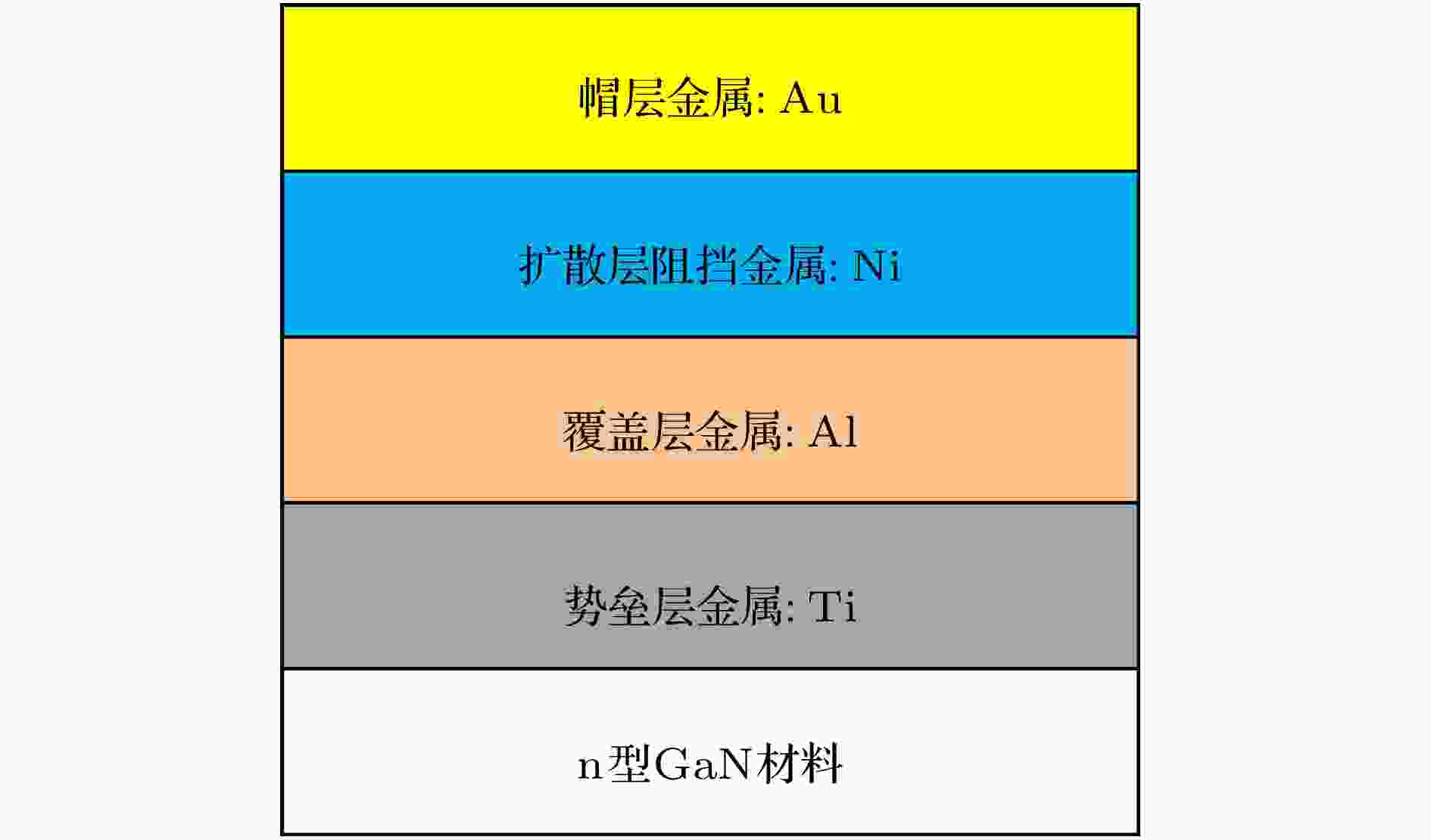
2019, 68 (20): 206101.
doi: 10.7498/aps.68.20190717
Abstract +
Ohmic contact is directly related to the performance of GaN device and is one of the important factors affecting device performance. In recent years, many research groups have studied the electrode materials and annealing conditions of n-type GaN Ohmic contacts. In this paper, the ohmic contact properties and structural characteristics of the Hf/Al electrode of a transition group metal refractory metal Hf system under different annealing conditions are studied, and compared with those of the Ti-based ohmic contact Ti/Al electrode. The specific contact resistivity of each electrode is measured by a dot-type transmission line model, and the structural characteristics of the electrode are analyzed by using an Auger electron spectrometer which can be analyzed in depth. The results show that the Hf/Al electrode under the same annealing condition exhibits superior ohmic contact performance compared with the conventional Ti/Al electrode. At the same time, the lowest specific contact resistivity of the Hf/Al electrode annealed in an N2 atmosphere at a low temperature of 650 ℃ for 60 s is 4.28×10–5 Ω·cm2. The in-depth analysis of Auger electron spectrum shows that the Hf/Al electrode has a solid phase reaction with the n-type GaN material. In addition, the cross section of each electrode is observed by auger electron spectroscopy. In the Hf/Al electrode sample, the metal-semiconductor interface does not show voids after annealing. This situation occurs at the sample interface where the Ti/Al electrode is annealed at 650 ℃ for 60 s in N2 atmosphere and annealed at 850 ℃ for 30 s in N2 atmosphere. This is one of the reasons why the Hf/Al electrode sample has a lower specific contact resistivity. At the same time, the surface of Hf/Al electrode and Ti/Al electrode annealed at 850 ℃ are characterized by using scanning electron microscope. It is found that the surfaces of both electrodes subject to high temperature annealing show a similar granular rough surface, and this rough surface has a certain influence on the electrical properties of the GaN device. The rough surface formed by the electrode under such high temperature annealing conditions is an urgent problem to be solved in the future research. In summary, the study in this paper indicates the use of Hf/Al to form an ohmic contact with n-type GaN under a low temperature annealing condition.
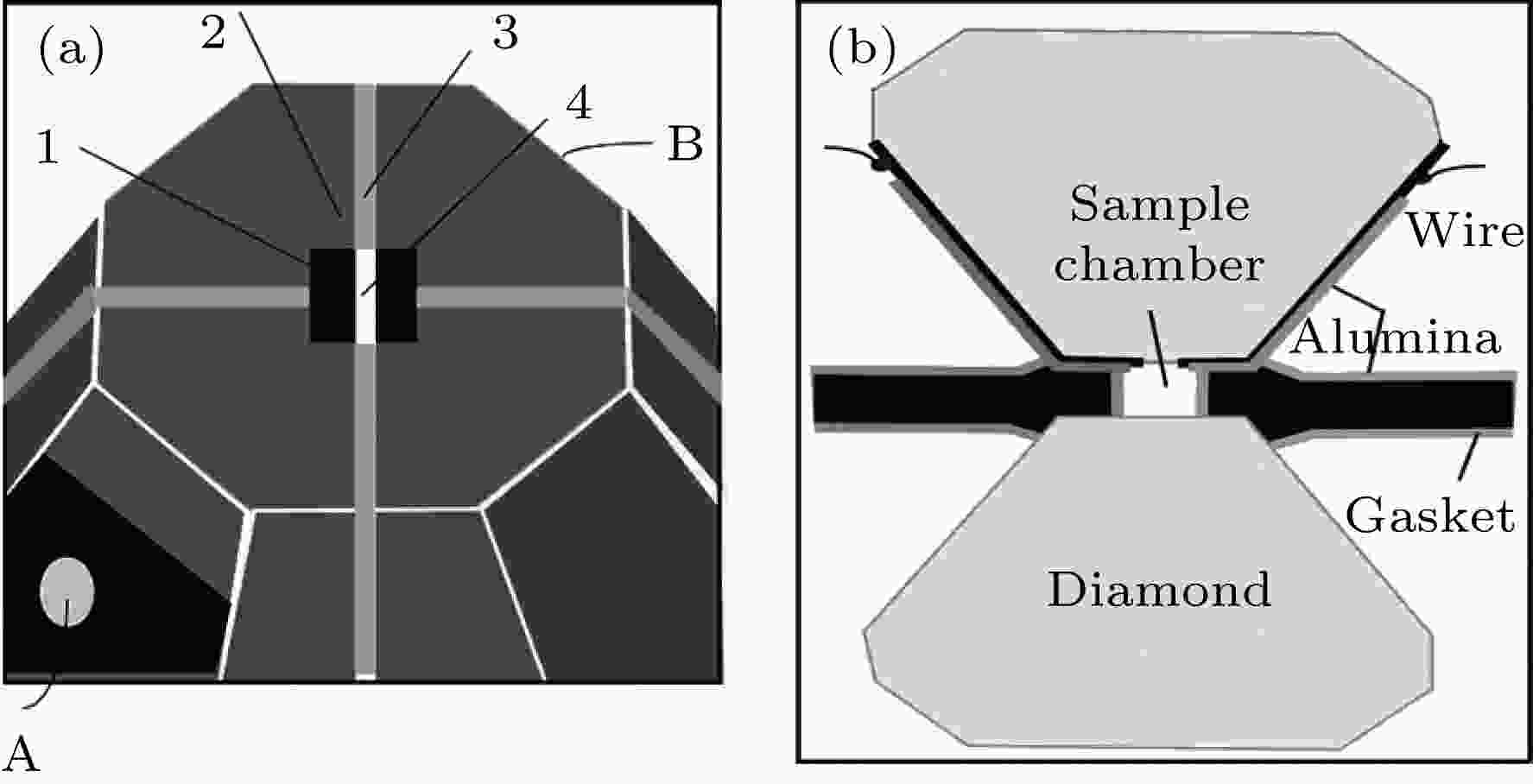
2019, 68 (20): 206401.
doi: 10.7498/aps.68.20190630
Abstract +
In this paper, the grain and grain boundary characteristics of pure rutile TiO2 under pressure are investigated by electrochemical impedance spectroscopy equipped with diamond anvil cell (DAC). Only one semi-circle can be detected under each pressure in a range of 1.4–11.5 GPa. With the pressure increasing, the shape of semi-circle is unchanged, while the size of semi-circle gradually decreases, which can be attributed to the decrease of bulk resistance due to the reduction of band gap under pressure. The absence of grain boundary characteristic in the impedance spectra signifying that Schottky barrier is not present at the grain boundaries. With further increasing pressure, an interesting phenomenon can be observed above 12.7 GPa. The shape of semi-circle is distorted, and exhibits two overlapping semi-circles. The first semi-circle (high frequency) originates from the contribution of bulk, and the second one (low frequency) can be ascribed to the effect of grain boundary. The occurrence of grain boundary semicircle indicates that the aggregation of space charges at the grain boundary. In this case, the phase transformation from rutile to baddeleyite structure occurs, the electric transport mechanism is changed, and new lattice defects are formed. Also, two discontinuous points (11.5 and 15.4 GPa) can be detected in the resistance curve. The remarkable change of resistance occurs at 12.7 GPa which is corresponding to the phase transition from rutile to baddeleyite phase. The occurrence of phase transition leads the new interfacial energy to occur, the total energy of system to increase, and the movement of carriers to impede. Thus, the resistance increases significantly, and the maximum value occurs at 15 GPa. Further analysis indicates that the space charge potential is modified with pressure increasing, implying that the electrical transport properties of TiO2 are related closely to phase transition. With the pressure increasing from 12.7 to 25.2 GPa, the irregular change of space charge potential can be attributed to the rutile and baddeleyite phase coexisting. When the pressure is higher than 25.2 GPa, the space charge potential is a constant (about 30 mV). According to the investigations, the TiO2 grain boundary space charge potential under pressure is mainly contributed from two parts: the electrostatic interaction and the elastic interaction.

2019, 68 (20): 206801.
doi: 10.7498/aps.68.20190070
Abstract +
[Ca24Al28O64]4+(4e–) eletride, as the first room-temperature stable inorganic electride, has attracted intensive attention because of its fascinating chemical, electrical, optical, and magnetic properties. However, it usually needs synthesizing through a complicated multistep process involving high temperature (e.g., 1350 °C), severe reduction (e.g., 700–1300 ℃ for up to 240 h in Ca or Ti metal vapor atmosphere) and post-purification. Owing to the H2O sensitivity of mayenite, the post-purification is quite troublesome once impurities are introduced. High-density, loosely bound encaged electrons with a low work function make it promise to possess practical applications. Therefore the facile method of massively producing the high-quality C12A7:e– with high Ne is extremely desired. In this work, C12A7:e– bulks are for the first time synthesized by simple spark plasma sintering process directly from a mixture of C12A7, CA and Ca powders under milder conditions (e.g., sintered at 1070 ℃ for 10 min in a vacuum). The obtained electride, which exhibits a relative density of 99%, an electron concentration of ~2.3×1021 cm–3 and an obvious absorption peak at 2.5 eV, is obtained via SPS process at 1100 ℃ for 10 min. Electronic structure is also investigated by electron paramagnetic resonance. The occurrence of Dysonian characteristic, a typical feature of good electronic conductors, strongly suggests that the electrons are trapped in mayenite cavities. Furthermore, the obtained C12A7:e– exhibits good sinterabilty on a crystal scale of 5–40 μm. Thermionic emission test results show that the thermionic emission begins to occur at 700 K and a large current density of 1.75 A/cm2 is obtained in the electron thermal emission from a flat surface of the polycrystalline C12A7:e– with an effective work function of 2.09 eV for a temperature of 1373 K with an applied electric field of ~35000 V/cm in a vacuum. Owing to no external reductant is needed, this developed route exhibits notable superiority over the conventional reduction method for phase-pure C12A7:e–. Therefore, these results not only suggest a novel precursor for fabricating mayenite electride but also make it possible to produce efficiently the electride in large volume.
CONDENSED MATTER: ELECTRONIC STRUCTURE, ELECTRICAL, MAGNETIC, AND OPTICAL PROPERTIES
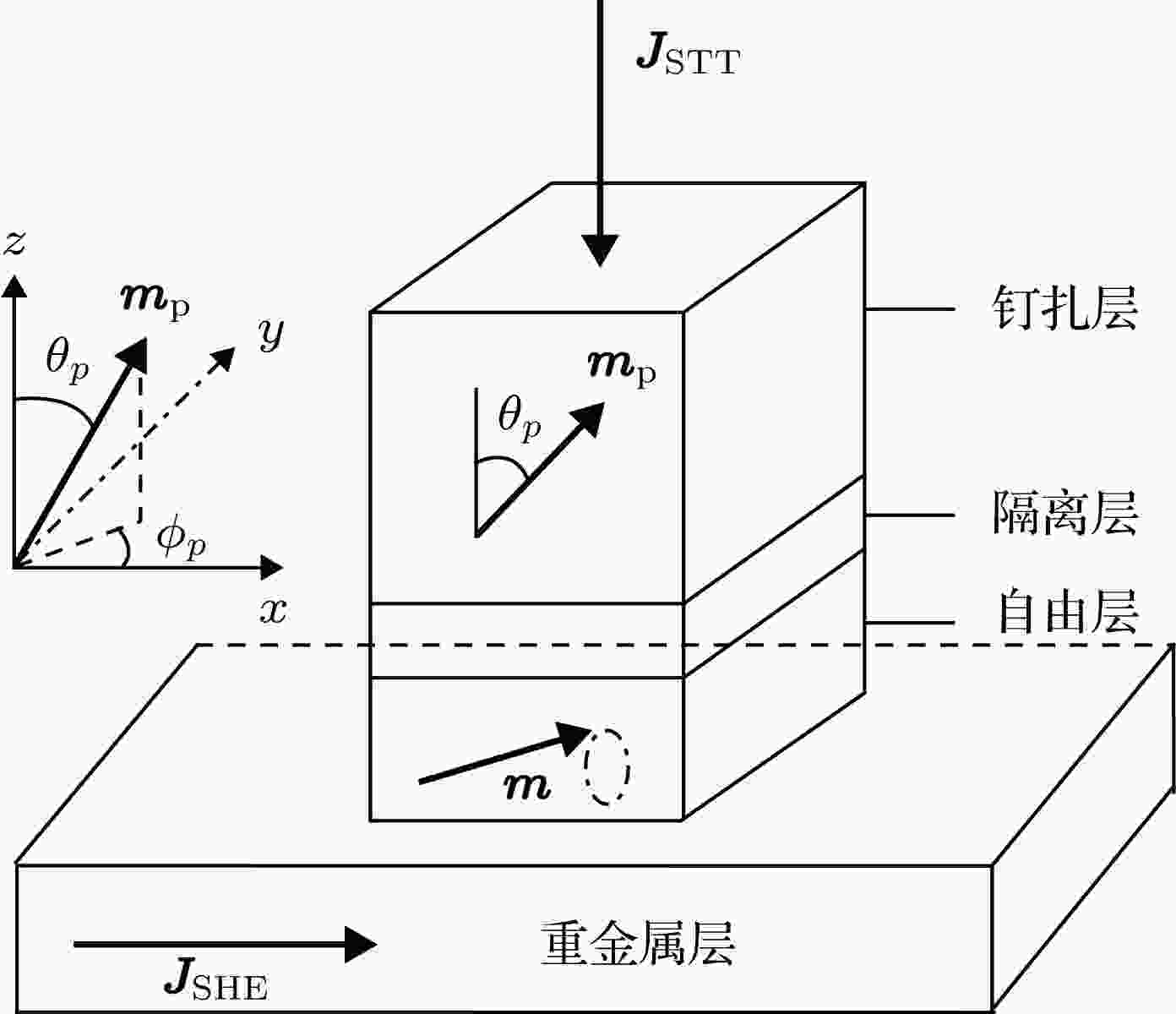
2019, 68 (20): 207201.
doi: 10.7498/aps.68.20190927
Abstract +
Spin-transfer torque-based magnetic random access memory is becoming more and more attractive in industry due to its non-volatility, fast switching speed and infinite endurance. However, it suffers energy and speed bottlenecks, so the magnetic tunnel junction urgently needs a new write scheme. Compared with the spin-transfer torque, emerging spin-orbit torque will replace spin-transfer torque as a new write scheme of magnetic storage technology for its faster writing speed and avoiding the barrier breakdown. A three-terminal magnetic tunnel junction consists of magnetic tunnel junction/heavy metal structure offers a promising perspective from a technological point of view in the design of new generation of magnetic random access memory, for it is possible to control the magnetization dynamics through two current densities of spin-transfer torque and the spin-orbit torque. In this paper, the stability of magnetic states in the three-terminal magnetic tunnel junction is studied theoretically. Through linearizing the Landau-Lifshitz-Gilbert equation including the spin-transfer torque and the spin-orbit torque defined in the spherical coordinates, the new equilibrium directions and linear differential equations are obtained. Performing linear stability analysis of the new equilibrium directions, the phase diagrams defined by the direction of pinned-layer magnetization vector and the current density of spin-orbit torque are obtained. Several magnetic states are distinguished in the phase diagram, such as in-plane precessional and stable states, out-of-plane precessional and stable states. When the pinned-layer magnetization vector rotates out of the film plane, through adjusting the direction of pinned-layer magnetization vector, the switching from stable state to precessional one can be realized. Orientating the pinned-layer magnetization vector in the film plane, neither the out-of-plane precession nor stable states emerges for the current density of spin-orbit torque and spin-transfer torque are relatively small. The instability current takes a minimum value with the pinned-layer magnetization vector nearly parallel or antiparallel to the easy axis of free layer and increases with the direction of pinned-layer magnetization vector deviating from these two locations. The magnetization reversal can be realized through adjusting the current density of spin-transfer torque, and the reversal time can decrease greatly under the assisting of spin-orbit torque. By showing the dependence of magnetization vector on the time of different magnetic states, the validity of phase diagram is confirmed. The selecting of the different directions of the pinned-layer magnetization vector provides an alternative way to control the current-driven magnetization dynamics. This will provide useful guide for the application of three-terminal magnetic tunnel junction.
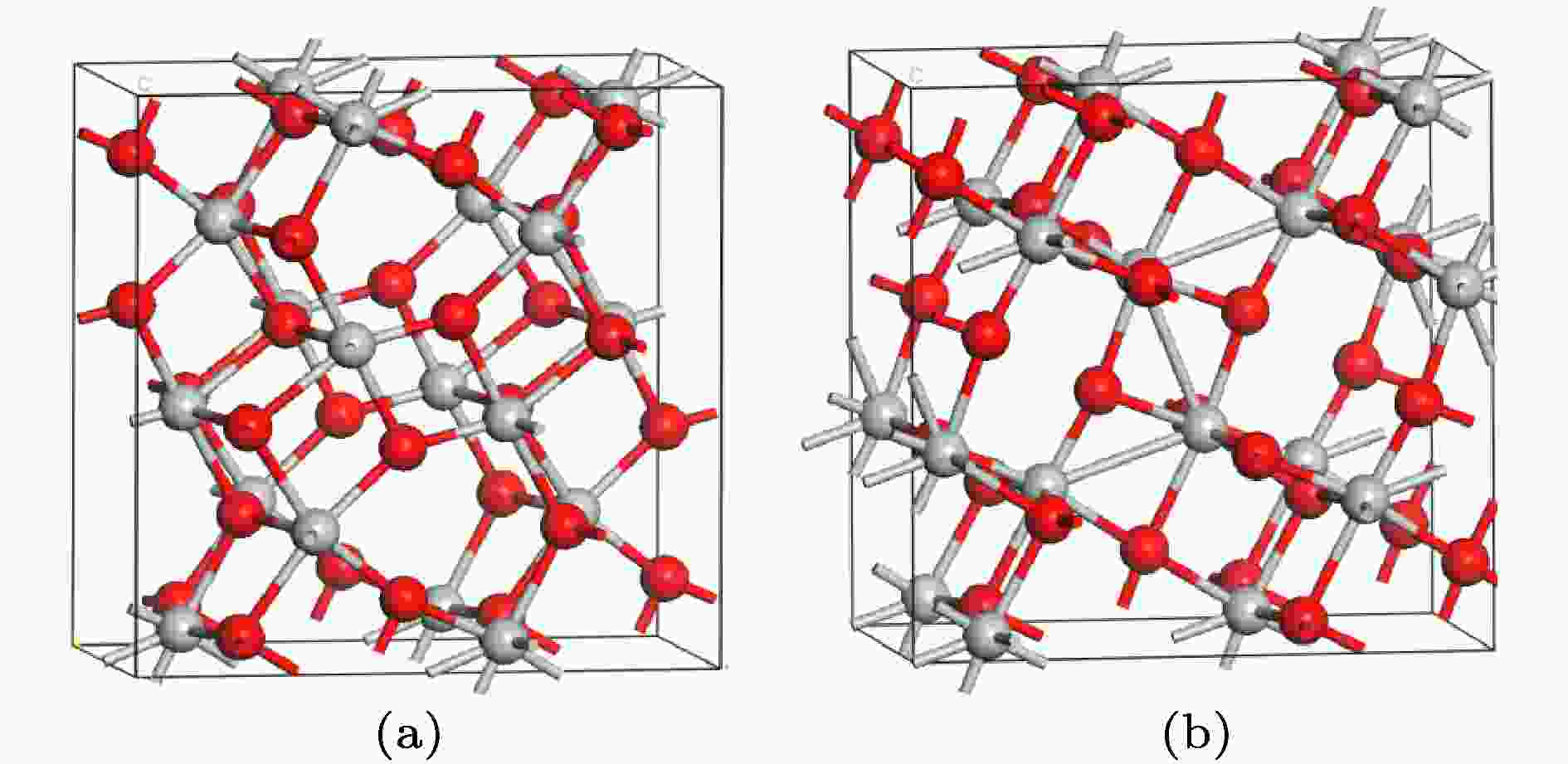
2019, 68 (20): 207301.
doi: 10.7498/aps.68.20190664
Abstract +
Ti3O5 is a highly anticipated functional material due to its intriguing physical properties and multi-incentive phase transition process. This material undergoes a reversible first-order phase transition between λ phase and β phase, accompanied by drastic changes in the electronic and atomic structure. The amazing way of changing phase such as light, heat, pressure and electric current makes this material promise to be used in future optical information storage and heat storage. In this work, structural, elastic, electronic and optical properties of λ-Ti3O5 and β-Ti3O5 are calculated by using a first-principles approach, according to density functional theory (DFT). The LSDA, GGA-PBE, GGA-91, GGA-PS and GGA-RP are compared among them to obtain a suitable method of characterizing the crystal structure and electronic structure of λ-Ti3O5 and β-Ti3O5. The energy gap at the Fermi level of β-Ti3O5 can be obtained only when the extra Coulomb correlation U effect of Ti 3d electrons is considered. A complete set of elastic parameters for both phases are first reported. The calculated elastic constant satisfies the Born stability criterion, indicating that λ phase and β phase have good mechanical structural stability. The two phases are more resistant to volume changes than to shape changes and both behave as ductile materials. On the (010) plane, the elastic anisotropy of λ phase is weaker than that of β phase. Studies on the electronic structure show that the local charge of Ti3 is transferred to Ti2, resulting in the transformation of the semiconductor β phase to the metal λ phase. There are large differences in optical property such as absorption and reflectivity between these two structures, indicating that they can be applied to the field of optical storage materials. In this paper we also present a new insight into the photoinduced phase transition process of this material. The mechanism of photoinduced phase transition from λ-Ti3O5 to β-Ti3O5 is considered as stimulated emission effect. The results are of significance particularly for practically applying Ti3O5 and understanding its phase change mechanism.
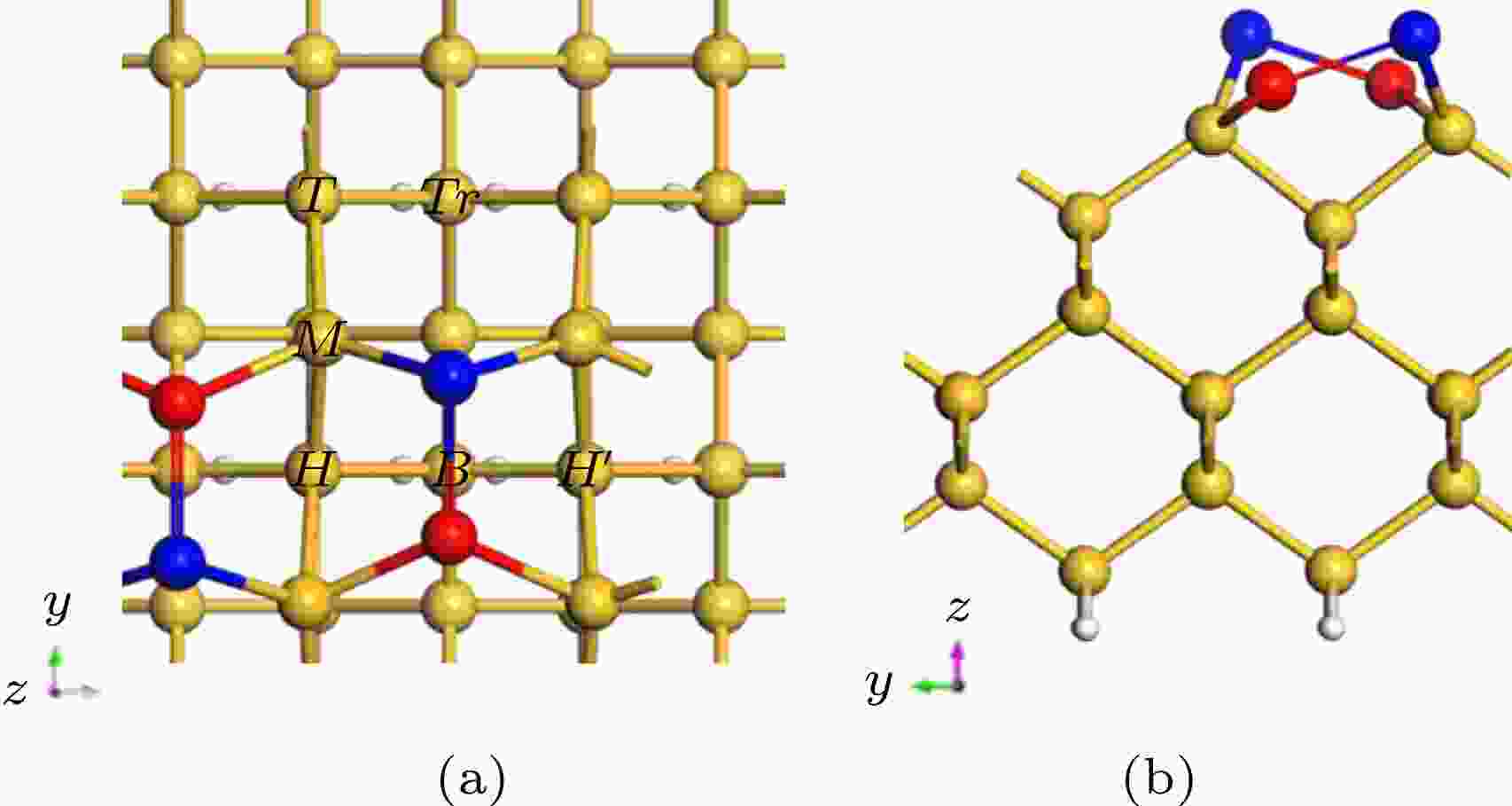
2019, 68 (20): 207302.
doi: 10.7498/aps.68.20190783
Abstract +
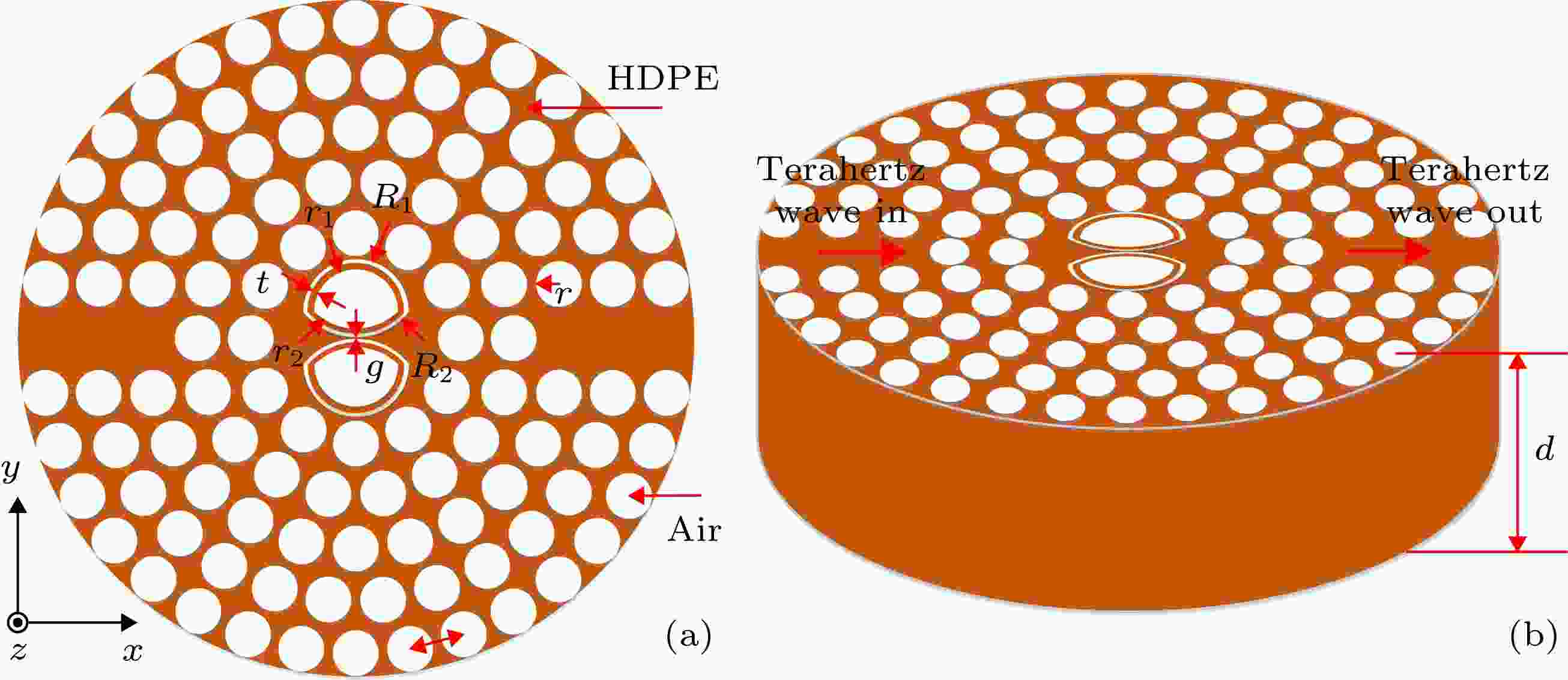
2019, 68 (20): 207801.
doi: 10.7498/aps.68.20191024
Abstract +
Refractive index sensing is attracting extensive attention in biochemical sensing using terahertz technology. Various structures with strong confinements have been used to design sensors for improving the interaction between the terahertz wave field and the analytes, such as photonic crystals, nanowires, plasmonic structures, and metamaterials. Terahertz wave sensors based on two-dimensional photonic crystal have been used in various areas ranging from disease diagnostics to environmental pollution detection. For improving the performance of terahertz sensor, a sensing scheme based on high-density polyethylene sunflower-typecircular photonic crystal structure is proposed. The designed sensor contains two symmetrical sample cells surrounding a cavity in a circular photonic crystal. The transmission properties of the terahertz wave sensor are analyzed based on COMSOL Multiphysics when the central sample cells are filled with analyte with different refractive indices. The sensor characteristics depending on the structure parameters are analyzed. The choice of these parameters is discussed. Finally, a sensitivity of 10.4 μm/RIU, Q-factor of 62.21, and figure-of-merit of 1.46 are realized. The results in this work are expected to be able to extend the circular photonic crystal-based sensor to terahertz wave region.
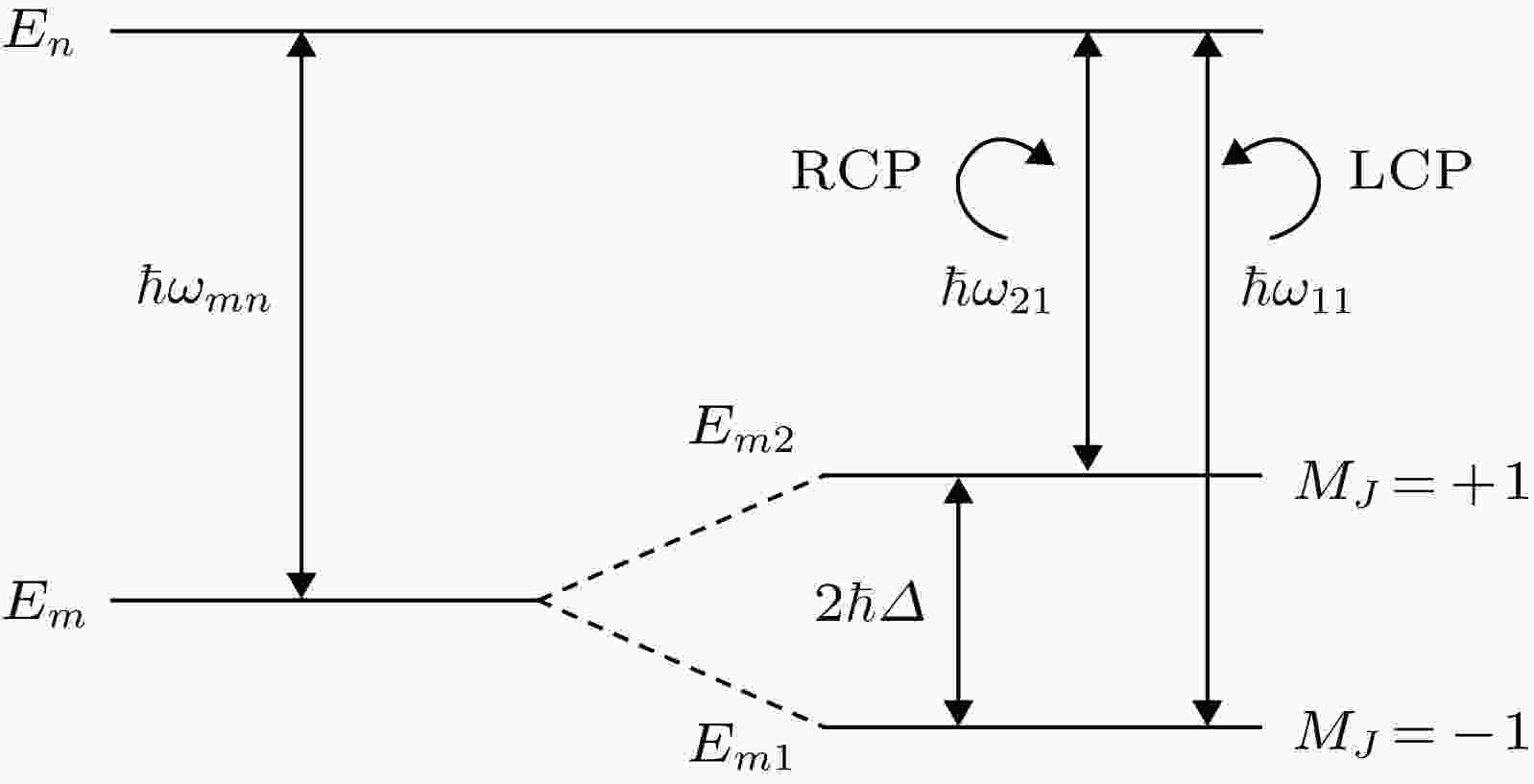
2019, 68 (20): 207802.
doi: 10.7498/aps.68.20190845
Abstract +
INTERDISCIPLINARY PHYSICS AND RELATED AREAS OF SCIENCE AND TECHNOLOGY
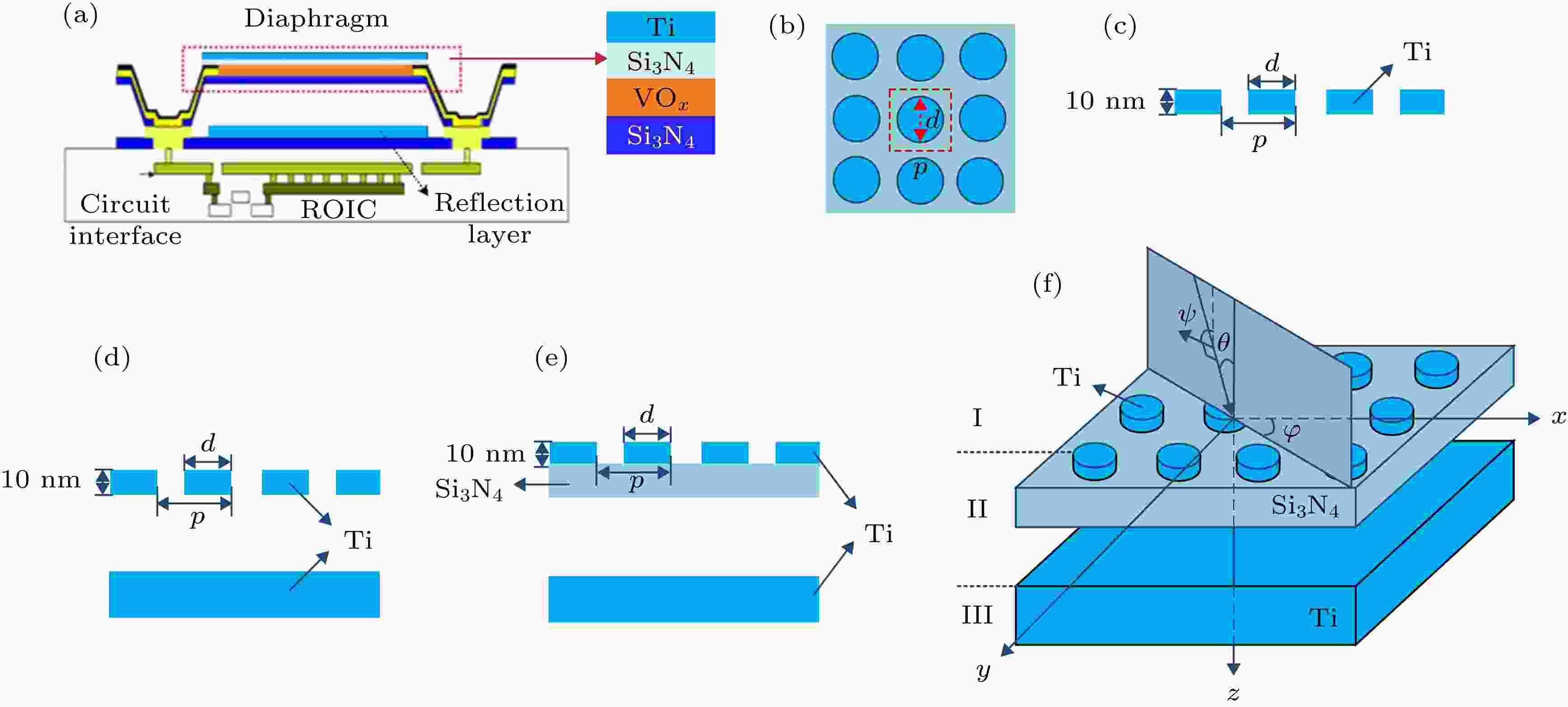
2019, 68 (20): 208501.
doi: 10.7498/aps.68.20190902
Abstract +
In this paper, a two-dimensional subwavelength periodic titanium (Ti) disk array integrated in micro-bridge structure is proposed to enhance the absorption of terahertz (THz) microbolometer. Based on the rigorous coupled wave analysis (RCWA) method, THz absorption characteristics of Ti disk arrays with different structure parameters in micro-bridge structure arrays are studied. Periodic disk array structure reduces the surface plasmon frequency of Ti, excites the spoof surface plasmons in the THz band and leads to resonance enhanced absorption. The resonance absorption frequency is determined by the structural parameters of Ti disk array including period and diameter while the absorption rate of THz wave is greatly affected by the thickness of Ti disks. The resonant cavity in micro-bridge structure can reduce the resonance frequency and enhance the coupling efficiency. The micro-bridge structure designed in this paper breaks the diffraction limit and traps the THz wave with a small period (37 μm). An absorption of nearly 90% is achieved at 3.5 THz. The structure meets the requirements of small size, high absorption and good process compatibility of the THz microbolometer.
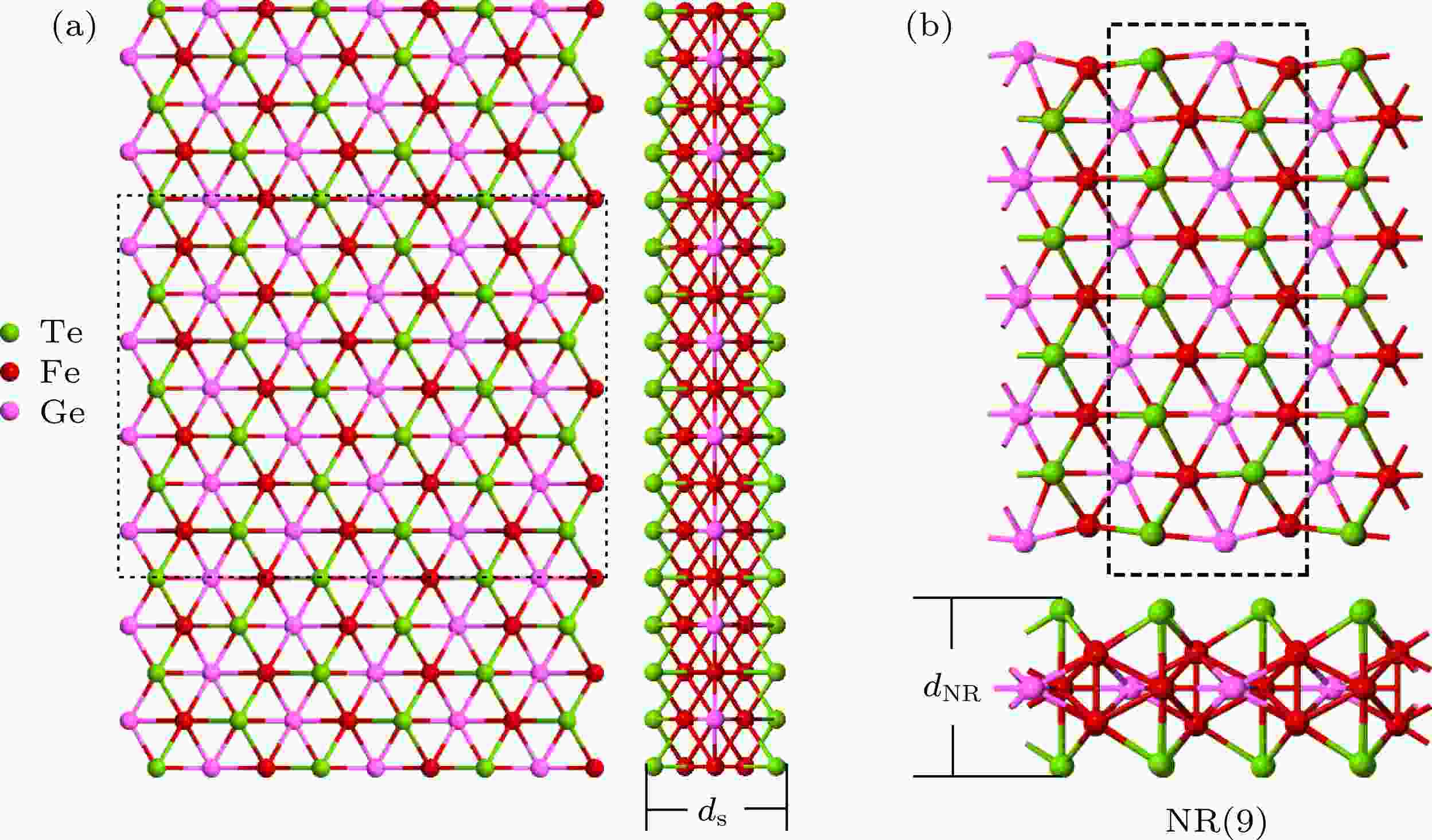
2019, 68 (20): 208502.
doi: 10.7498/aps.68.20191103
Abstract +
Fe3GeTe2 monolayer is one of the currently fabricated 2-dimensional (2D) ferromagnetic materials. Based on the first principle of density functional theory, we here study the structural stability and magneto-electronic properties of nanoribbons NR(n) obtained by cutting 2D Fe3GeTe2. The calculated binding energy and molecular dynamics simulation results identify that nanoribbons are rather stable. The large magnetic moment and magnetized energy prove the extremely high magnetism stability for NR(n). Moreover, with the increase of the width, the magnetic moment of the nanoribbons generally increases, and gradually tends to a stable value. In particular, the nanoribbons possess a high spin polarization efficiency at the Fermi level (SPF). For example, the SPF for NR(5) is up to 100%. With the width variation of the nanoribbons, the SPF has a significant odd-even oscillating effect, that is, the spin-polarization of the odd nanoribbons is higher than that of the adjacent even nanoribbons, especially when the width is in the range of n ≤ 12. This means that the α-spin and β-spin are quite different in the density of states at the Fermi level when the width is odd or even. This may be caused by the difference of the quantum confinement effect for the odd or even nanoribbons, respectively. Meanwhile, when the width of the nanoribbons is wide enough, the odd-even oscillation effect of the spin polarizability is stabilized in a relatively small range, and the nanoribbons finally tend to be 2D Fe3GeTe2 monolayer. The nanoribbons have an obvious advantage on SPF over the 2D Fe3GeTe2 monolayer. In addition, the calculation of the strain effect demonstrates that the strain can flexibly tune the SPF varying from approximately zero to 85.6%, and the SPF reaches a maximum of 85.6% at a stretch of 4%, which is a fairly high value; then reaches a minimum at a stretch of 8%, almost being zero, which means that a mechanical switch can be designed to control the low-bias spin transition, allowing it work between high spin polarization and spin unpolarization.

2019, 68 (20): 208801.
doi: 10.7498/aps.68.20190597
Abstract +











